D Link WA130D1 D-Link DWA-130 Wireless N USB Adapter User Manual Manual 1
D Link Corporation D-Link DWA-130 Wireless N USB Adapter Manual 1
D Link >
Contents
- 1. Manual 1
- 2. Manual 2
Manual 1
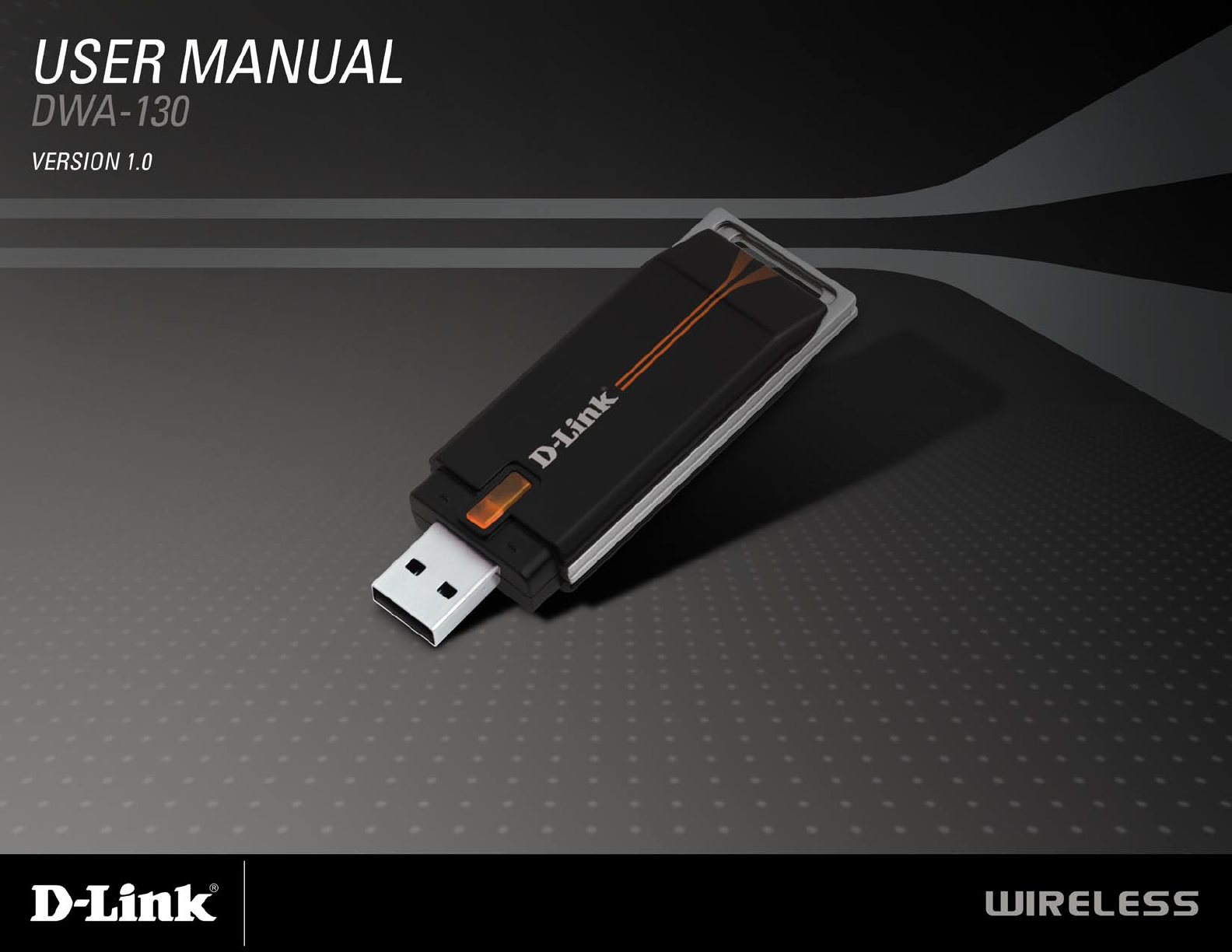

2D-Link DWA-130 User Manual
Table of Contents
Product Overview ...................................................3
Package Contents ..............................................................3
System Requirements .......................................................3
Introduction .......................................................................4
Features .............................................................................5
Hardware Overview ...........................................................6
Installation ...........................................................7
Getting Started ..................................................................7
Remove Existing Installations .....................................7
Disable Other Wireless Adapters .................................8
Wireless Installation Considerations ................................10
Adapter Installation..........................................................11
Configuration ...................................................... 17
D-Link Wireless Connection Manager..............................17
Wireless Networks ....................................................18
Wi-Fi Protected Setup (WPS) ....................................19
My Wireless Networks ..............................................22
Add Profile ...........................................................23
Modify Profile .......................................................24
Support .....................................................................25
About ........................................................................26
Connect to a Wireless Network ................................. 27
Using Windows® Vista™ ................................................... 27
Using Windows® XP ........................................................29
Wireless Security ................................................. 30
What is WPA? ..................................................................30
Configure WPA/WPA2 Passphrase ..................................31
Using the D-Link Connection Manager ......................31
Using Windows® Vista ..............................................33
Using the Windows® XP Utility .................................35
Configure WPA/WPA2 (RADIUS) .....................................37
Using the D-Link Connection Manager ......................37
Troubleshooting ................................................... 38
Wireless Basics ................................................... 42
Wireless Modes ...............................................................46
Networking Basics ................................................ 47
Check your IP address .....................................................47
Windows® XP/2000 Users ........................................47
Windows Vista™ Users ..............................................47
Statically Assign an IP address ........................................48
Windows® XP/2000 Users ........................................48
Windows Vista™ Users ..............................................49
Technical Specifications ......................................... 50
Contacting Technical Support ................................... 51
Warranty ........................................................... 52
Registration........................................................ 58
Table of Contents

3D-Link DWA-130 User Manual
Section 1 - Product Overview
• D-Link DWA-130 Wireless N™ USB Adapter
• Cradle
• Manual and Warranty on CD
• D-Link Wireless Connection Manager on CD
• Quick Installation Guide
System Requirements
• A computer or laptop with an available USB 2.0 port
• Windows® Vista™, 2000 (Service Pack 4) or XP (Service Pack 2)
• CD-ROM Drive
• 300MHz processor and at least 64MB of RAM
• A draft 802.11n or 802.11g access point or wireless router
Product Overview
Package Contents

4D-Link DWA-130 User Manual
Section 1 - Product Overview
Introduction
The DWA-130 Wireless N™ USB Adapter is a convenient wireless connectivity solution for desktop or notebook PCs. Instead of
stringing Ethernet cables to your PC or dismantling your desktop computer case, the DWA-130 can enable Draft 802.11n wireless
connectivity by simply utilizing your desktop or notebook PC’s USB port.
Powered by Wireless N™ technology, the DWA-130 provides a faster wireless connection and superior reception than 802.11g*. The
DWA-130 is designed for use in bigger homes and for those that demand higher bandwidth networking. Maximize wireless performance
by connecting this USB Adapter to a Wireless N™ router and stay connected from virtually anywhere in the home. This USB Adapter
supports WPA and WPA2 encryption to prevent outside intrusion and protect your personal information from being exposed.
D-Link’s Quick Setup Wizard guides you step-by-step through the installation process. The D-Link Wireless Manager is included with
this product to keep track of all your most frequently accessed networks.
Compact in size, robust in speed the DWA-130 Wireless N™ USB Adapter is great for travel and a convenient solution for providing
high performance wireless connectivity to your desktop or notebook PC. Enjoy the many benefits of wireless connectivity today!
* Maximum wireless signal rate derived from IEEE Standard 802.11g and Draft 802.11n specifications. Actual data throughput will vary. Network conditions and
environmental factors, including volume of network traffic, building materials and construction, and network overhead, lower actual data throughput rate. Environmental
conditions will adversely affect wireless signal range.

5D-Link DWA-130 User Manual
Section 1 - Product Overview
Features
• Compact size for placement anywhere.
• Convenience of Plug & Play installation.
• Fully 802.11g compatible.
• Draft 802.11n compliant.
• Powered by the USB port; no external power source required.
• USB 2.0 standard*.
• You can securely connect to a wireless network using WPA/WPA2 (Wi-Fi Protected Access) providing you a much
higher level of security for your data and communication than has previously been available. You may also use 802.1x
for wireless authentication.
• Position the DWA-130 almost anywhere in your workspace to achieve the best reception possible.
• Supports Infrastructure networks via an access point
• User-friendly configuration and diagnostic utilities.
* Using a USB 1.1 port will adversely affect throughput.
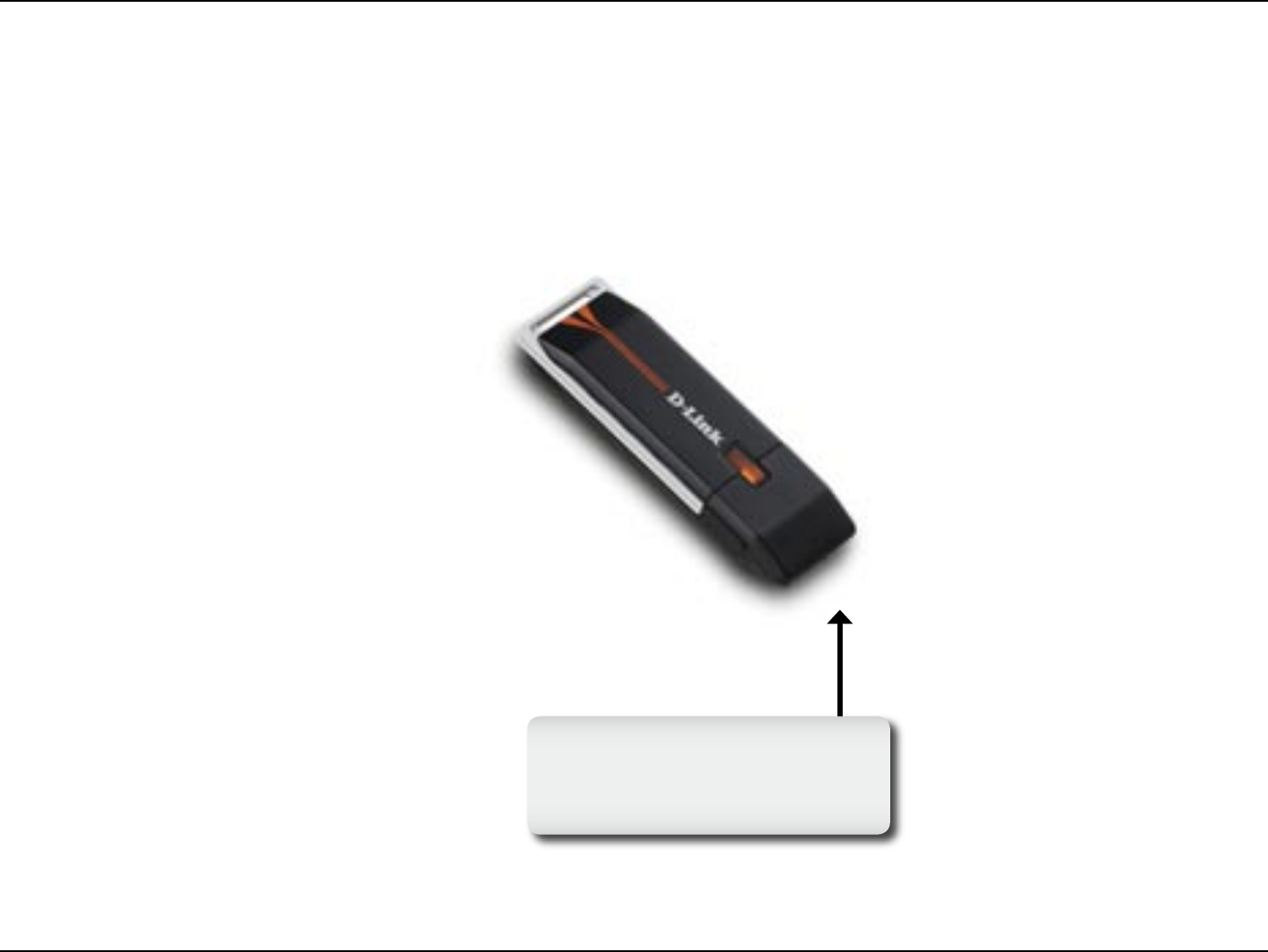
6D-Link DWA-130 User Manual
Section 1 - Product Overview
Hardware Overview
USB Port
Used to connect the DWA-130 to
your computer.

7D-Link DWA-130 User Manual
Section 2 - Installation
Getting Started
Installation
This section will walk you through the installation process. If you have a built-in wireless adapter, please disable it in device manager
before installing your D-Link adapter. Also, if you have previously installed another wireless adapter, please make sure any software
is uninstalled.
Before installing your new D-Link wireless adapter, please verify the following:
• Remove any previous installations of wireless adapters
• Disable any built-in wireless adapters
• Verify the settings such as the SSID and security settings of the network(s) you want to connect to
Remove Existing Installations
If you’ve installed a different manufacture’s adapter or a different model D-Link adapter, make sure the software is uninstalled before
installing the new software. Some utilities may cause a conflict with the new software. If you plan to use multiple adapters at different
times, make sure the utilities are not set to load when your computer boots up. Windows® XP users may use the built-in wireless
utility for all adapters.
To remove any old software:
Windows® XP/Vista™ users: Click Start > Control Panel > Add or Remove Programs.
Windows® 2000 users: Click Start > Settings > Control Panel > Add or Remove Programs.

8D-Link DWA-130 User Manual
Section 2 - Installation
Disable Other Wireless Adapters
Most newer laptops may include a built-in wireless adapter. To prevent any conflicts with the D-Link wireless adapter, it is recommended
to disable the wireless adapter (as well as any unused Ethernet adapters).
From the desktop, right-click on the My Computer icon and select Properties.
Click the Hardware tab and then click Device Manager. Scroll down the list and
click the + sign to the left of Network Adapters.
Right-click the adapter you would like to disable and select Disable.
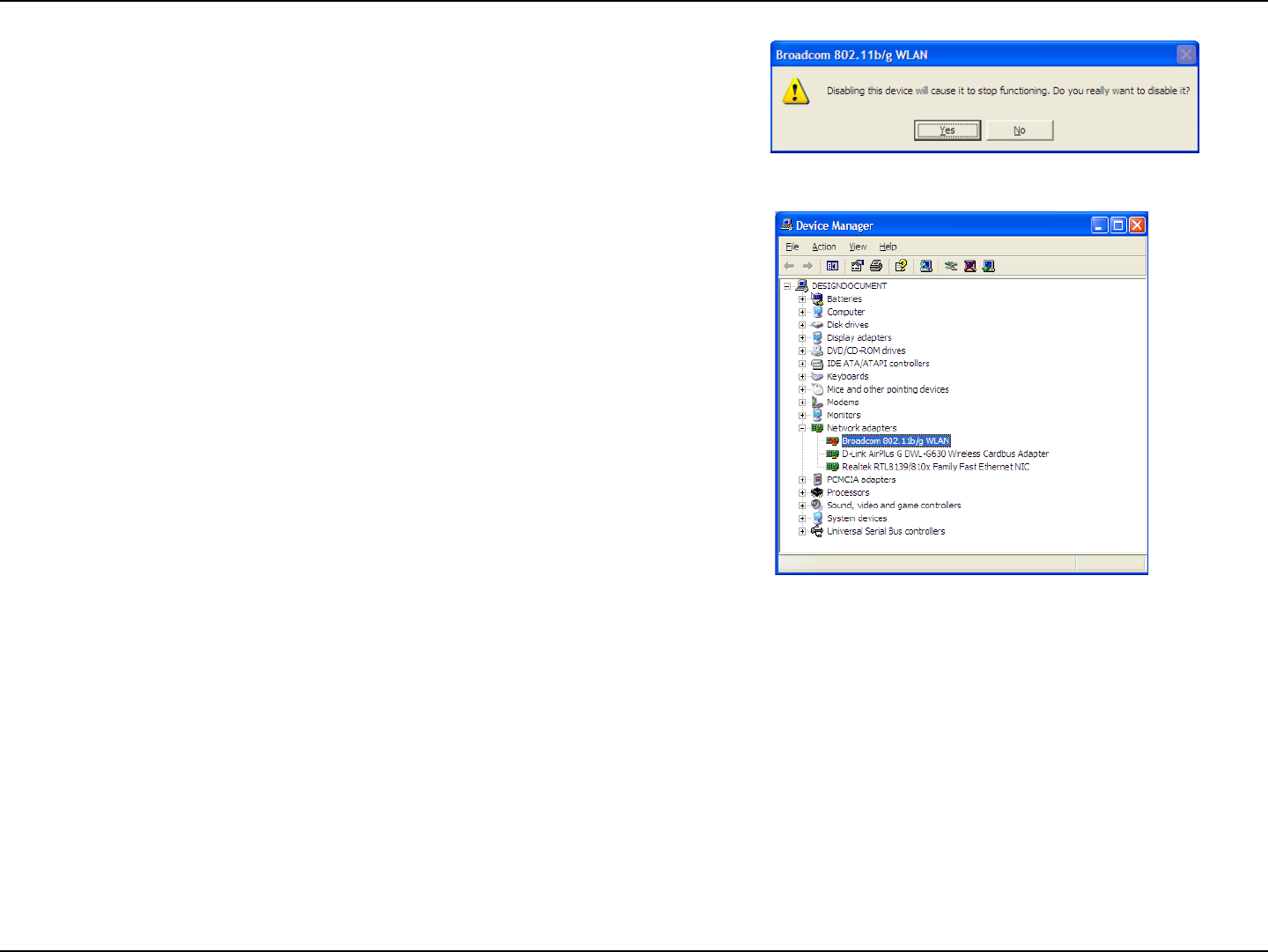
9D-Link DWA-130 User Manual
Section 2 - Installation
Click Yes to disable the adapter.
The adapter is now disabled. When disabled, a red X will be displayed.
Disabling the adapter will not remove the drivers. If you would like to use
the adapter, simply right-click it and select Enable.

10D-Link DWA-130 User Manual
Section 2 - Installation
Wireless Installation Considerations
The D-Link wireless adapter lets you access your network using a wireless connection from virtually anywhere within the operating
range of your wireless network. Keep in mind, however, that the number, thickness and location of walls, ceilings, or other objects that
the wireless signals must pass through, may limit the range. Typical ranges vary depending on the types of materials and background
RF (radio frequency) noise in your home or business. The key to maximizing wireless range is to follow these basic guidelines:
1. Keep the number of walls and ceilings between the D-Link adapter and other network devices to a minimum - each
wall or ceiling can reduce your adapter’s range from 3-90 feet (1-30 meters.) Position your devices so that the number
of walls or ceilings is minimized.
2. Be aware of the direct line between network devices. A wall that is 1.5 feet thick (.5 meters), at a
45-degree angle appears to be almost 3 feet (1 meter) thick. At a 2-degree angle it looks over 42 feet (14 meters)
thick! Position devices so that the signal will travel straight through a wall or ceiling (instead of at an angle) for
better reception.
3. Building Materials make a difference. A solid metal door or aluminum studs may have a negative effect on range.
Try to position access points, wireless routers, and computers so that the signal passes through drywall or open
doorways. Materials and objects such as glass, steel, metal, walls with insulation, water (fish tanks), mirrors, file
cabinets, brick, and concrete will degrade your wireless signal.
4. Keep your product away (at least 3-6 feet or 1-2 meters) from electrical devices or appliances that generate RF
noise.
5. If you are using 2.4GHz cordless phones or X-10 (wireless products such as ceiling fans, lights, and home security
systems), your wireless connection may degrade dramatically or drop completely. Make sure your 2.4GHz phone
base is as far away from your wireless devices as possible. The base transmits a signal even if the phone in not in
use.
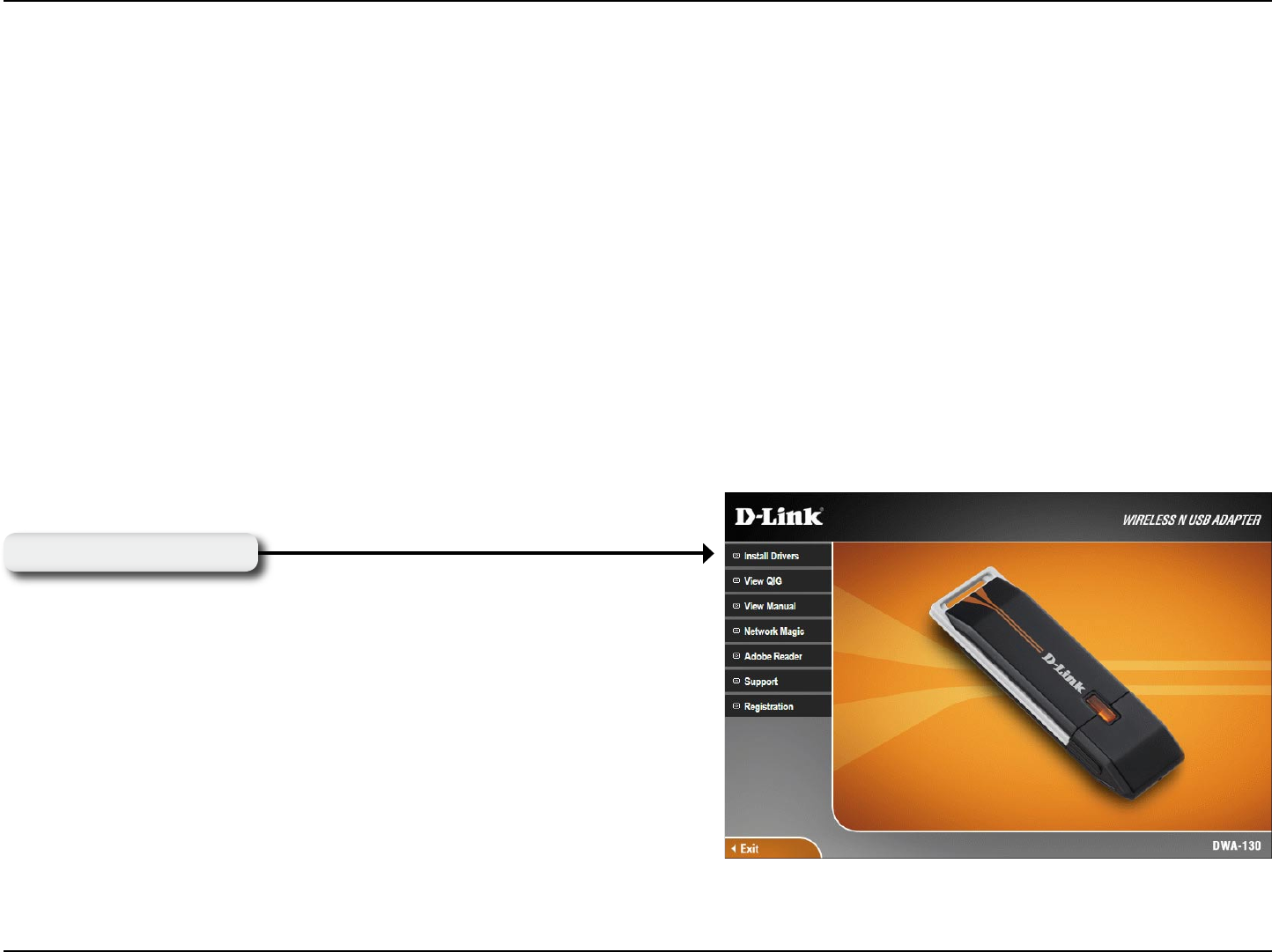
11D-Link DWA-130 User Manual
Section 2 - Installation
Warning: Do NOT install the DWA-130 USB Adapter into your computer before installing the driver software from the D-Link
CD.
Turn on the computer and Insert the D-Link DWA-130 Driver CD in the CD-ROM drive.
If the CD Autorun function does not automatically start on your computer, go to Start > Run. In the run box type “D:\DWA130.
exe” (where D: represents the drive letter of your CD-ROM drive).
When the autorun screen appears, click Install Drivers.
Adapter Installation
Click Install Drivers
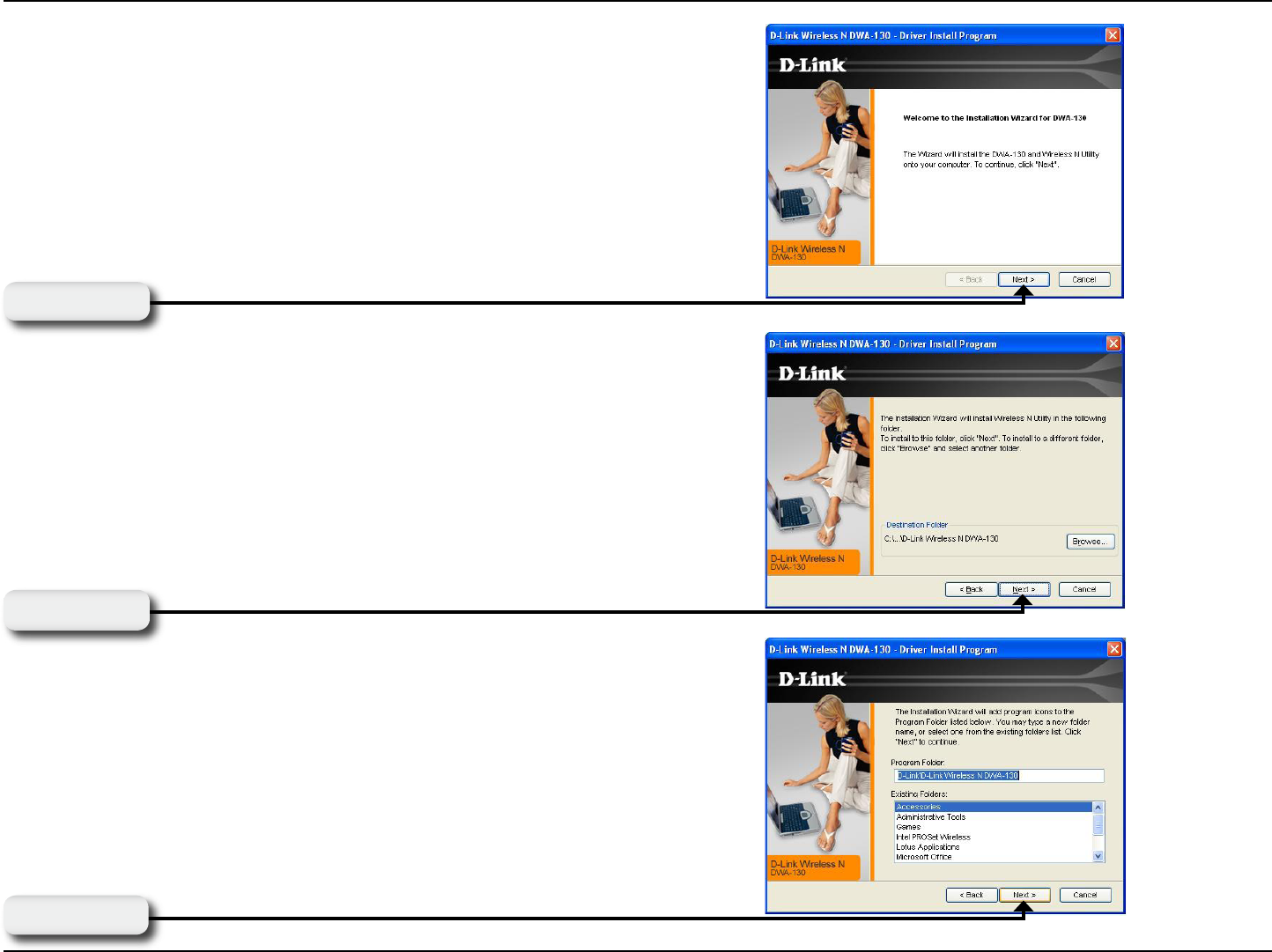
12D-Link DWA-130 User Manual
Section 2 - Installation
The InstallShield Wizard window will appear.
By default setup will install to the default location: C:\Program Files\
D-Link\DWA-130, where C: represents the drive letter of your hard
drive. To install to a different location click Browse and specify the
location.
Select the Program Files folder location.
Click Next
Click Next
Click Next
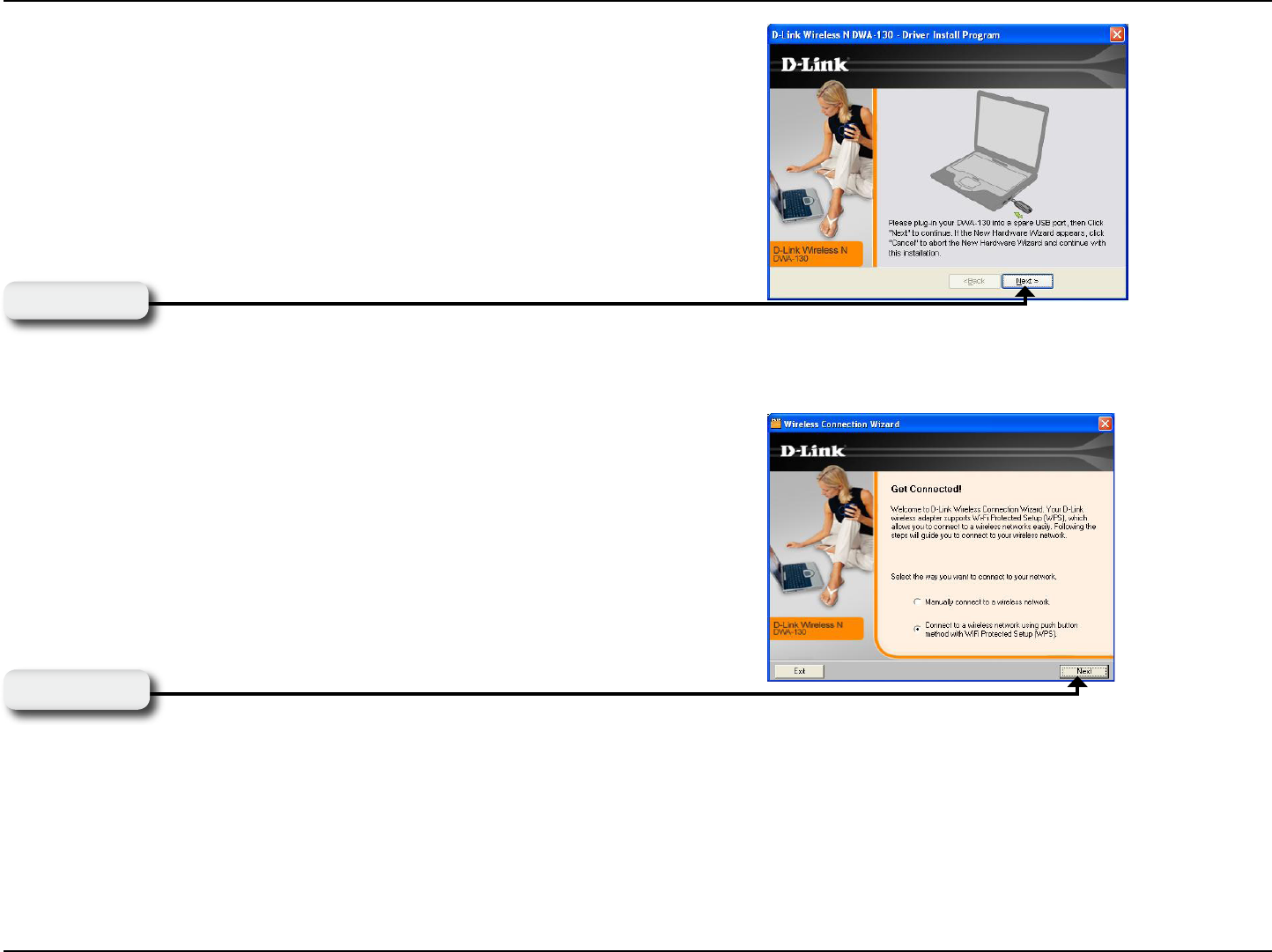
13D-Link DWA-130 User Manual
Section 2 - Installation
The Wireless Connection Wizard will now appear.
If you want to manually connect to a wireless network, refer to page 15.
The following instructions will connect you to a wireless network using
Wi-Fi Protected Setup (WPS).
Insert the adapter into an available USB port on your computer.
If the Found New Hardware Wizard appears, click Cancel.
Click Next
Click Next
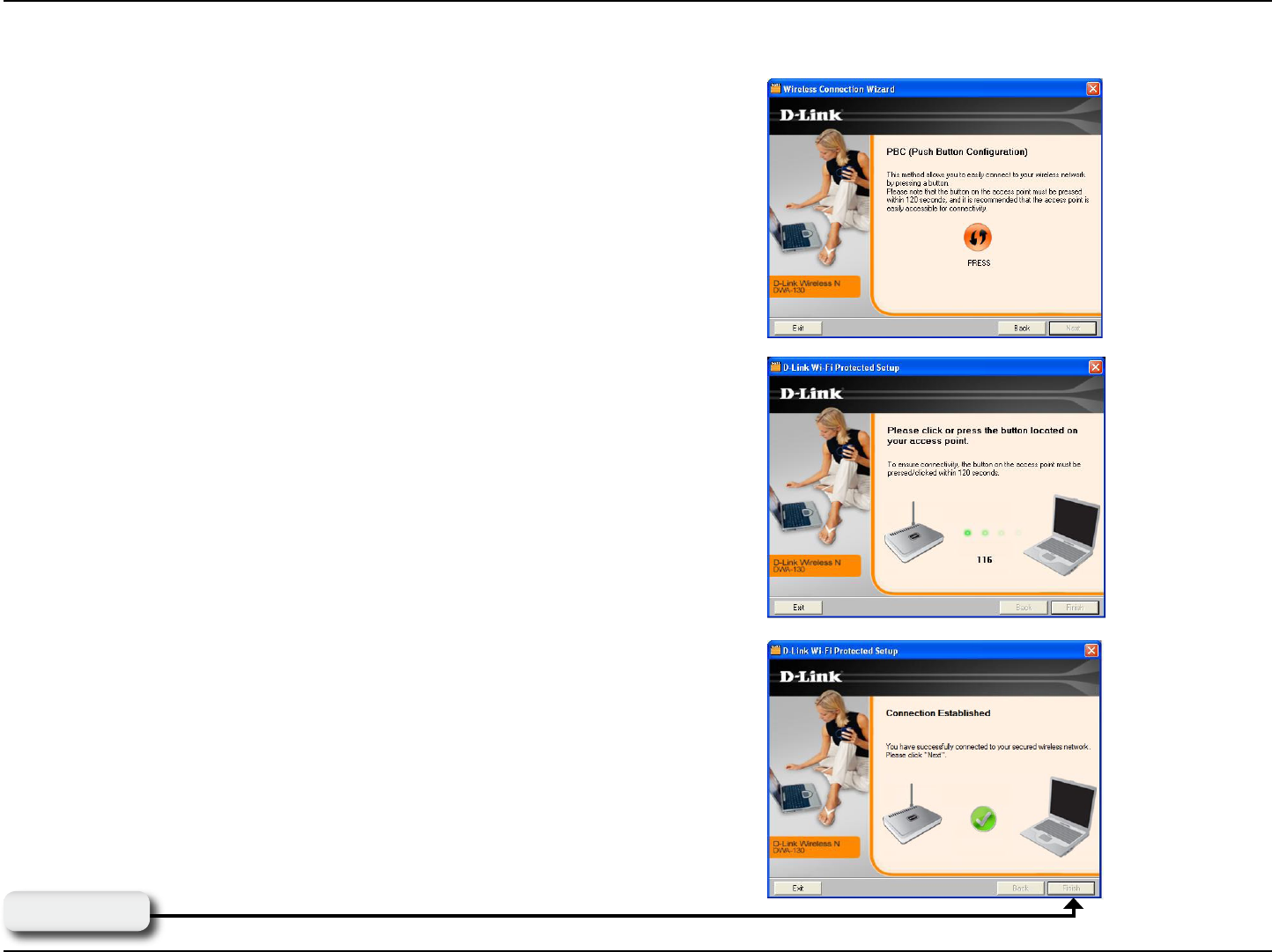
14D-Link DWA-130 User Manual
Section 2 - Installation
To connect to your network using the WPS push button configuration
method, click the virtual button as shown in the screenshot.
Press the WPS button on your access point or wireless router within 2
minutes to establish connectivity.
When this screen appears, you have successfully connected to your
wireless network. Click Next to complete your setup.
Click Next
Push Button Configuration (PBC)

15D-Link DWA-130 User Manual
Section 2 - Installation
To manually connect to your wireless network, select Manually connect
to a wireless network and then click Next.
Click Next
Click the Scan button to display a list of wireless networks (site survey).
Click on the network name (SSID) and click Next.
Click Next
Enter the network name (SSID) manually. If you enter the SSID incorrectly,
you will automatically be brought to the site survey page. Click Scan to
display the site survey page.
Click Next
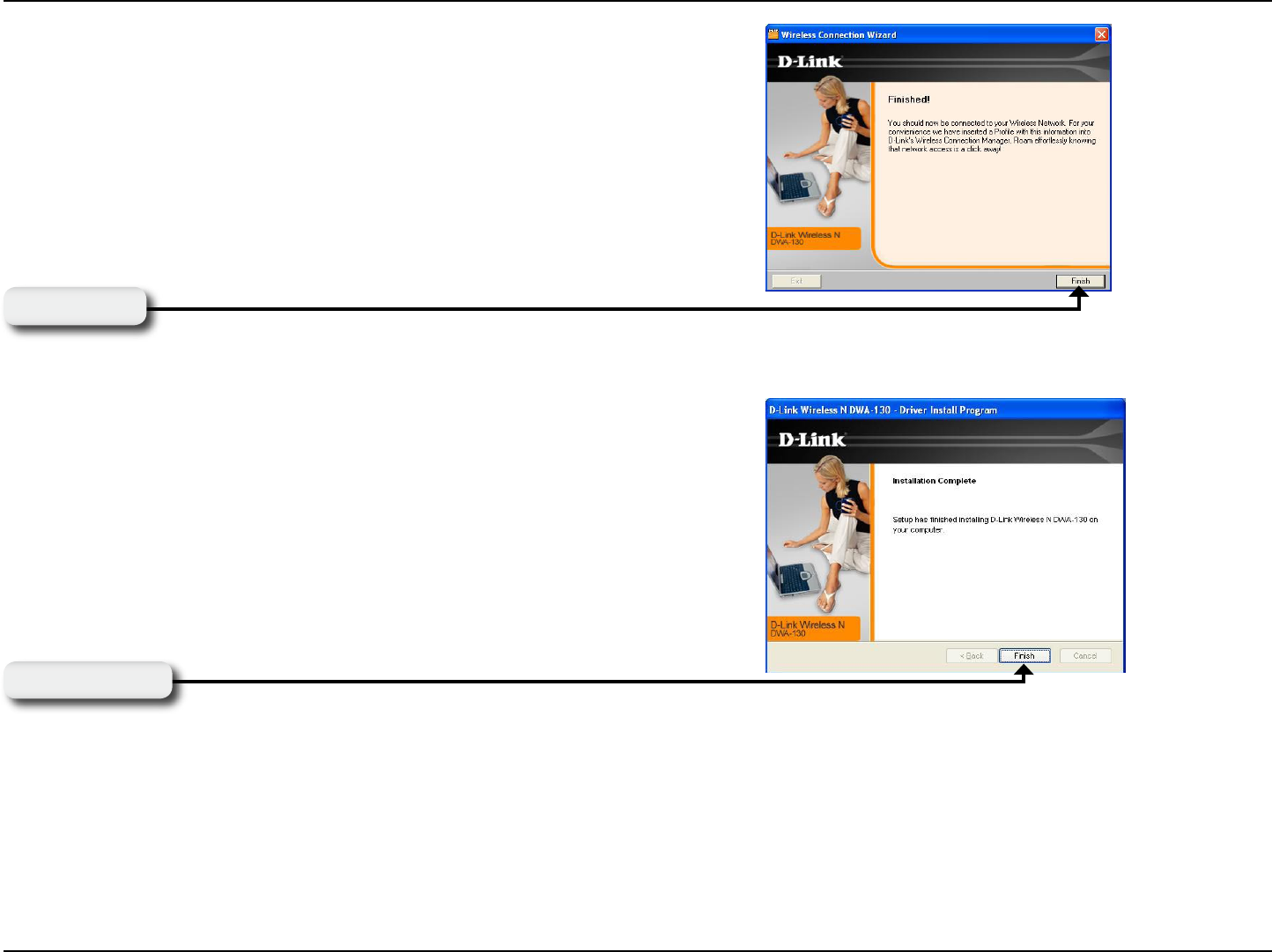
16D-Link DWA-130 User Manual
Section 2 - Installation
Click Finish to continue. If you are prompted to reboot your computer,
select Yes, I want to restart my computer now.
Click Finish
When this screen appears, you are successfully connected to your wireless
network. Click Next to complete your setup.
Click Next
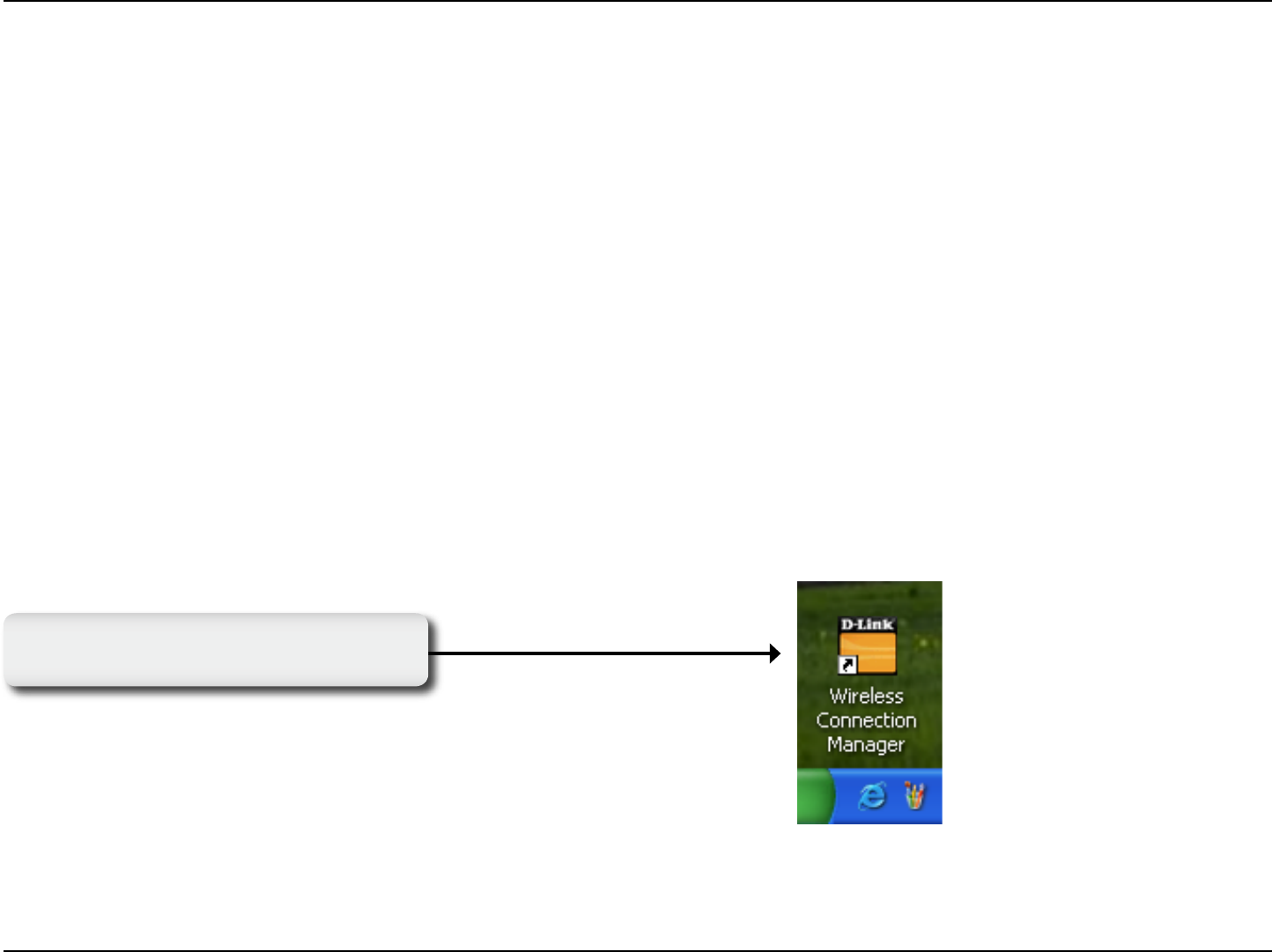
17D-Link DWA-130 User Manual
Section 3 - Configuration
Configuration
This section will show you how to configure your new D-Link wireless adapter using the D-Link Utility as well as the Windows® XP
Zero Configuration Utility and Vista WLAN Autoconfiguration.
D-Link Wireless Connection Manager
The D-Link DWA-130 uses the Wireless Connection Manager as the management software. The manager provides the user an easy
interface to change any settings related to the wireless adapter. Clicking on the Wireless Connection Manager icon on the desktop
will start the Configuration.
If you are using Windows® Vista™ please skip to page 27 or Windows® XP skip to page 29.
Double-click the Wireless Connection
Manager icon on your desktop.
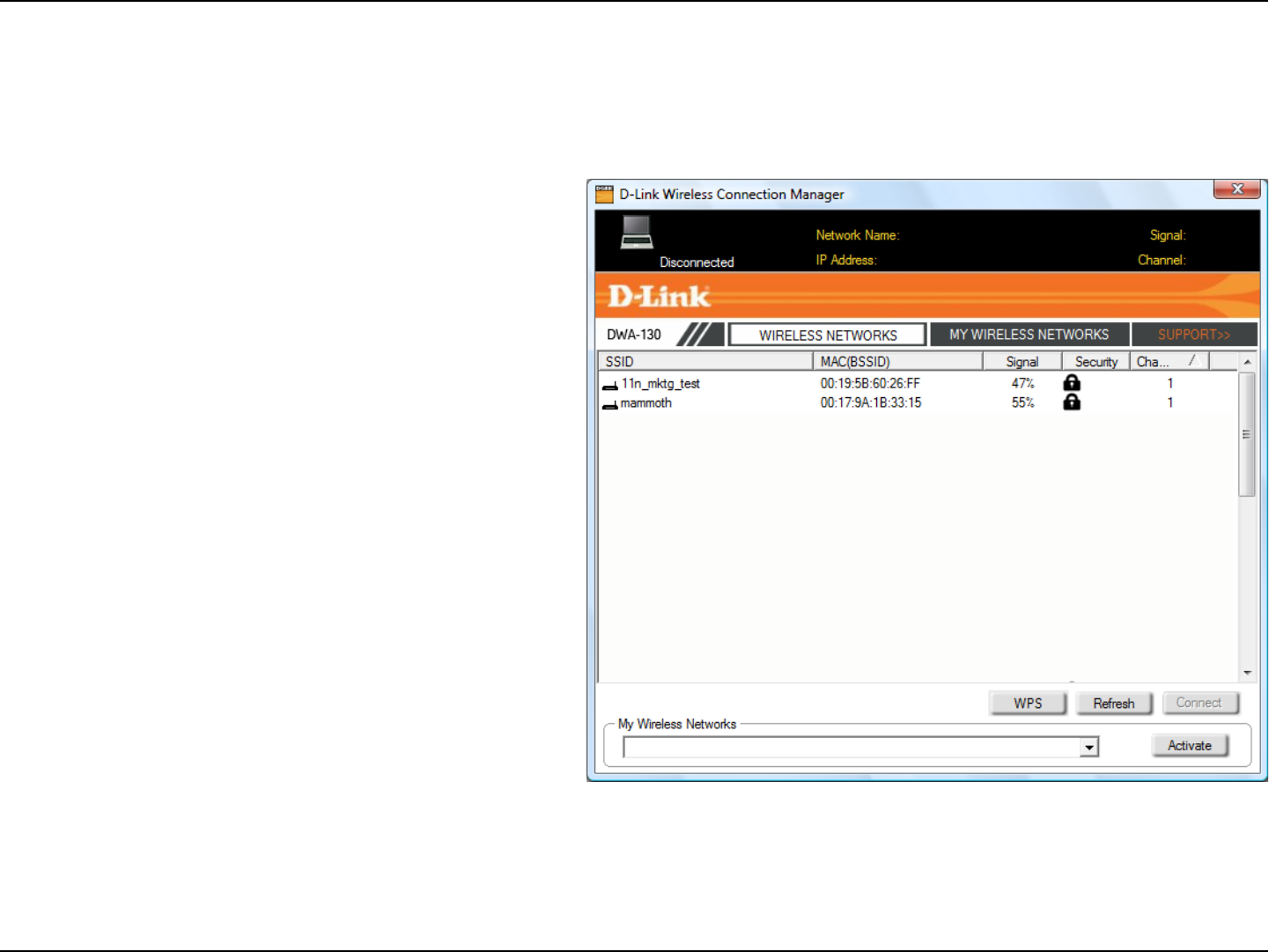
18D-Link DWA-130 User Manual
Section 3 - Configuration
Wireless Networks
The SSID (Service Set Identifier) is the name of the
wireless network.
Displays the MAC address of the wireless device.
Displays the Link Quality of the wireless
connection.
If there is a “lock” icon, this means the wireless
network is secure. You must know the encryption
key/security settings to connect.
Displays the channel of the wireless network.
Connect to a wireless network using Wi-Fi Protected
Setup. Refer to the next page.
Rescans for available wireless networks in your
area.
Highlight a wireless network and click the Connect
button. If the network is secure, a pop-up window
will appear. Enter the security information to connect
(refer to the Wireless Security section for more
information).
Select a wireless network profile from the
drop-down menu and click Activate to connect. Allow
up to 30 seconds to connect.
MAC:
SSID:
Channel:
Signal:
Security:
Refresh Button:
Connect Button:
Activate Button:
The Wireless Networks (Site Survey) page will display all wireless networks that are available in your area. To connect to a network,
simply highlight the wireless network (SSID) and click Connect.
WPS Button:
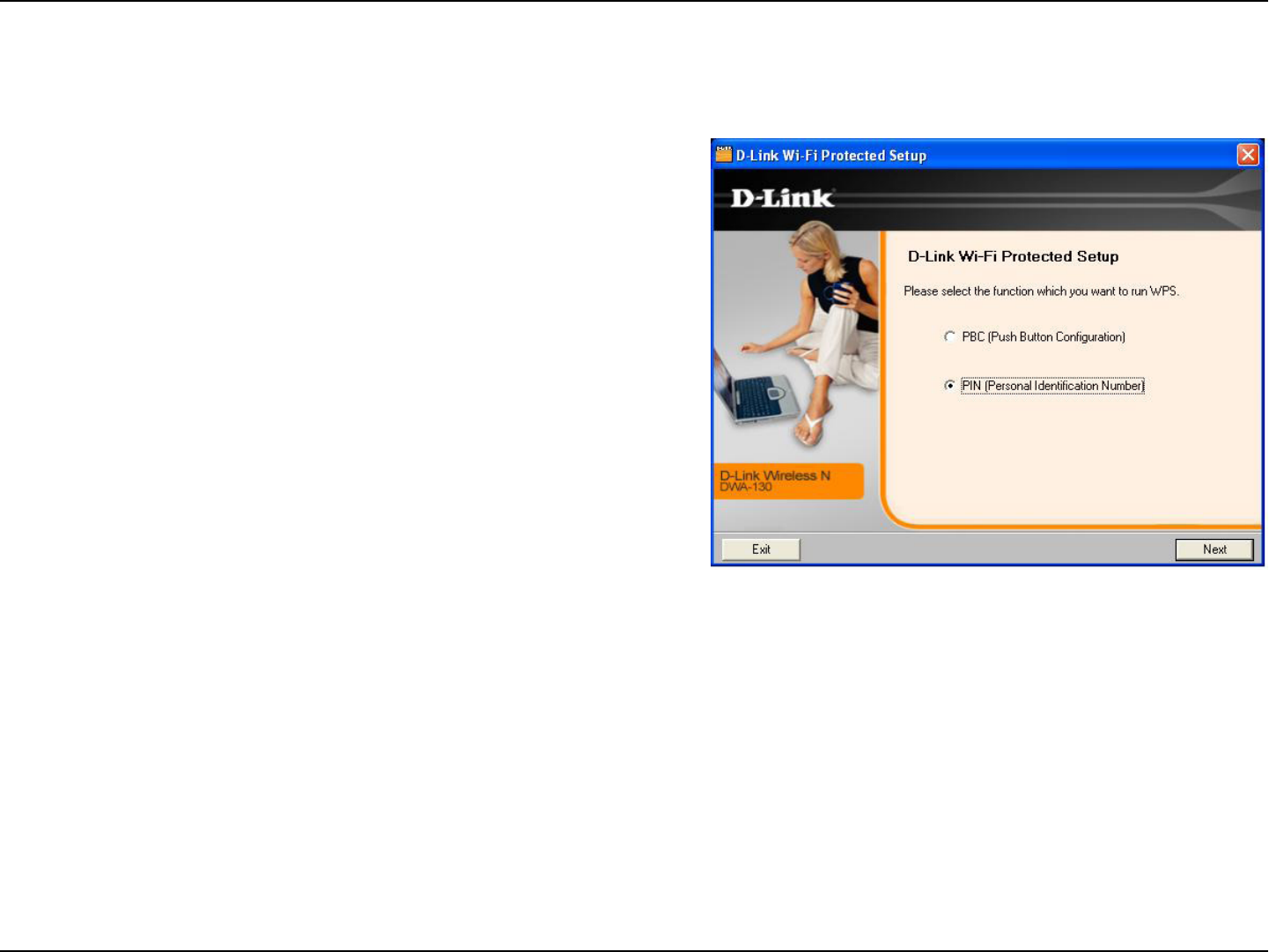
19D-Link DWA-130 User Manual
Section 3 - Configuration
Wi-Fi Protected Setup (WPS)
Wi-Fi Protected Setup (WPS) System is designed for easy setup of
security-enabled Wi-Fi networks. It is recommended to have the access
point or wireless router nearby during setup.
For more information on WPS, visit the Wi-Fi Alliance website at www.
wi-fi.org.
“Push Button Configuration” (PBC) is a virtual button in the utility
that connects you to other WPS-enabled devices. A connection can be
established by clicking on the virtual button, then pushing the physical
button on the access point or wireless router within 120 seconds. Refer
to page 14.
“Personal Identification Number” (PIN) is a unique number generated
randomly by the wireless adapter’s utility. Entering this number in the
utility of the WPS-enabled wireless router or access point connects you
with the intended wireless network. Refer to the next page for more
information.
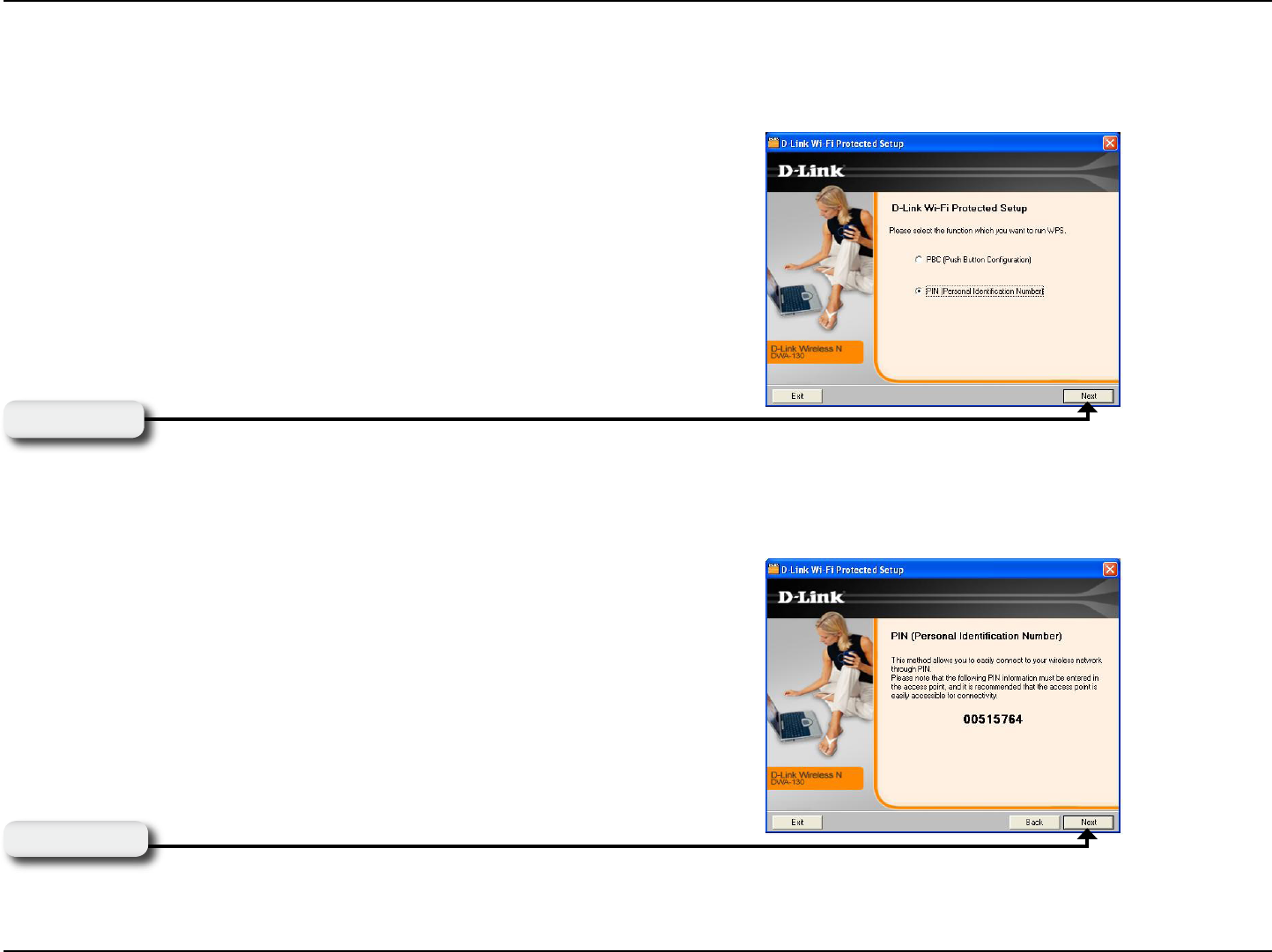
20D-Link DWA-130 User Manual
Section 3 - Configuration
If you want to connect using the PBC method, refer to page 14. To use
the PIN method, select PIN (Personal Identification Number) and click
Next.
Click Next
Make sure your access point or wireless router is close by. Write down the
number on the screen. Enter this number in your access point or wireless
router. Please refer to the manufacture’s manual for instructions.
Once you click Next, you will have 2 minutes to enter this number in
your access point or wireless router.
Click Next
Personal Identification Number (PIN)
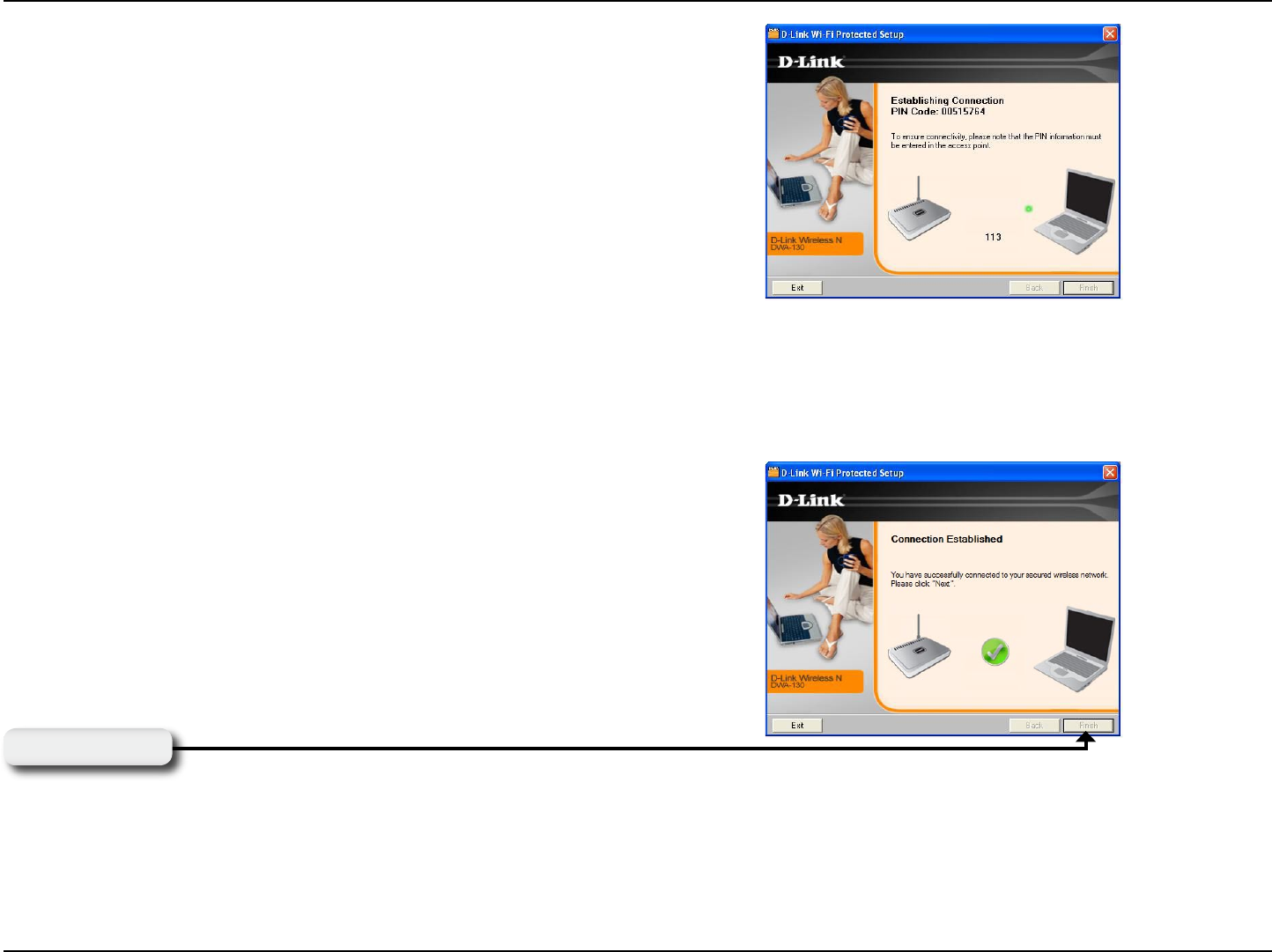
21D-Link DWA-130 User Manual
Section 3 - Configuration
The adapter will try to establish connectivity to your access point or
wireless router.
When this screen appears, you have successfully established connectivity.
Click Finish to complete your setup.
Click Finish
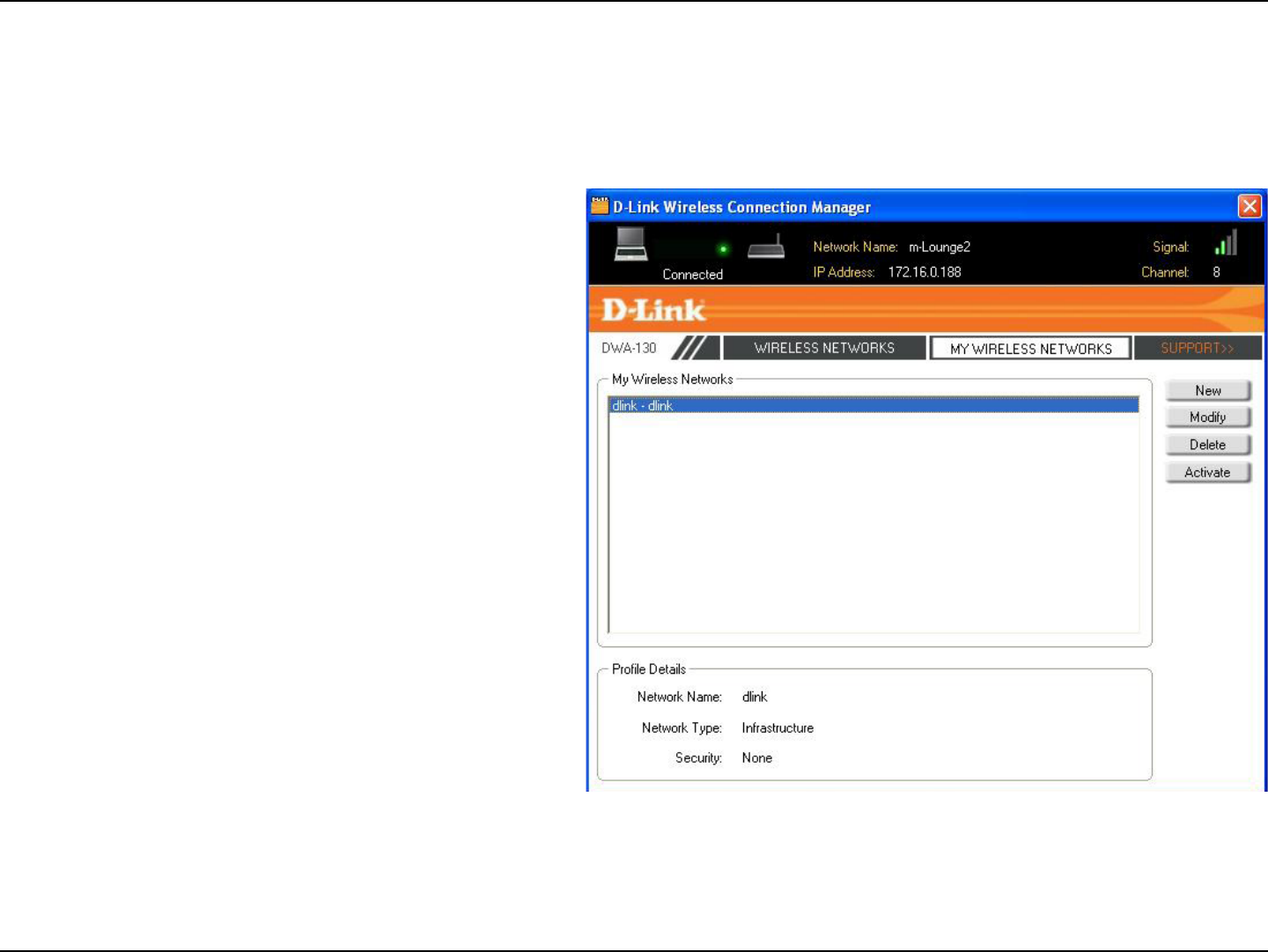
22D-Link DWA-130 User Manual
Section 3 - Configuration
My Wireless Networks
The My Wireless Networks page will allow you to create, edit, and delete wireless network profiles. Every time you connect to a
network using the Wireless Networks page, a profile will automatically be created.
New Button:
Modify:
Click New to create a new wireless network profile
(refer to page 23).
Click Modify to edit a current profile (refer to page
24).
Click Delete to remove a profile.
Click Activate to use a profile. Allow up to 30 seconds
to connect to the wireless network.
The Profile Details section will display information
about the wireless network such as the network
name (SSID), network type (Infrastructure), and if
the network is secured.
Delete:
Activate:
Profile Details:
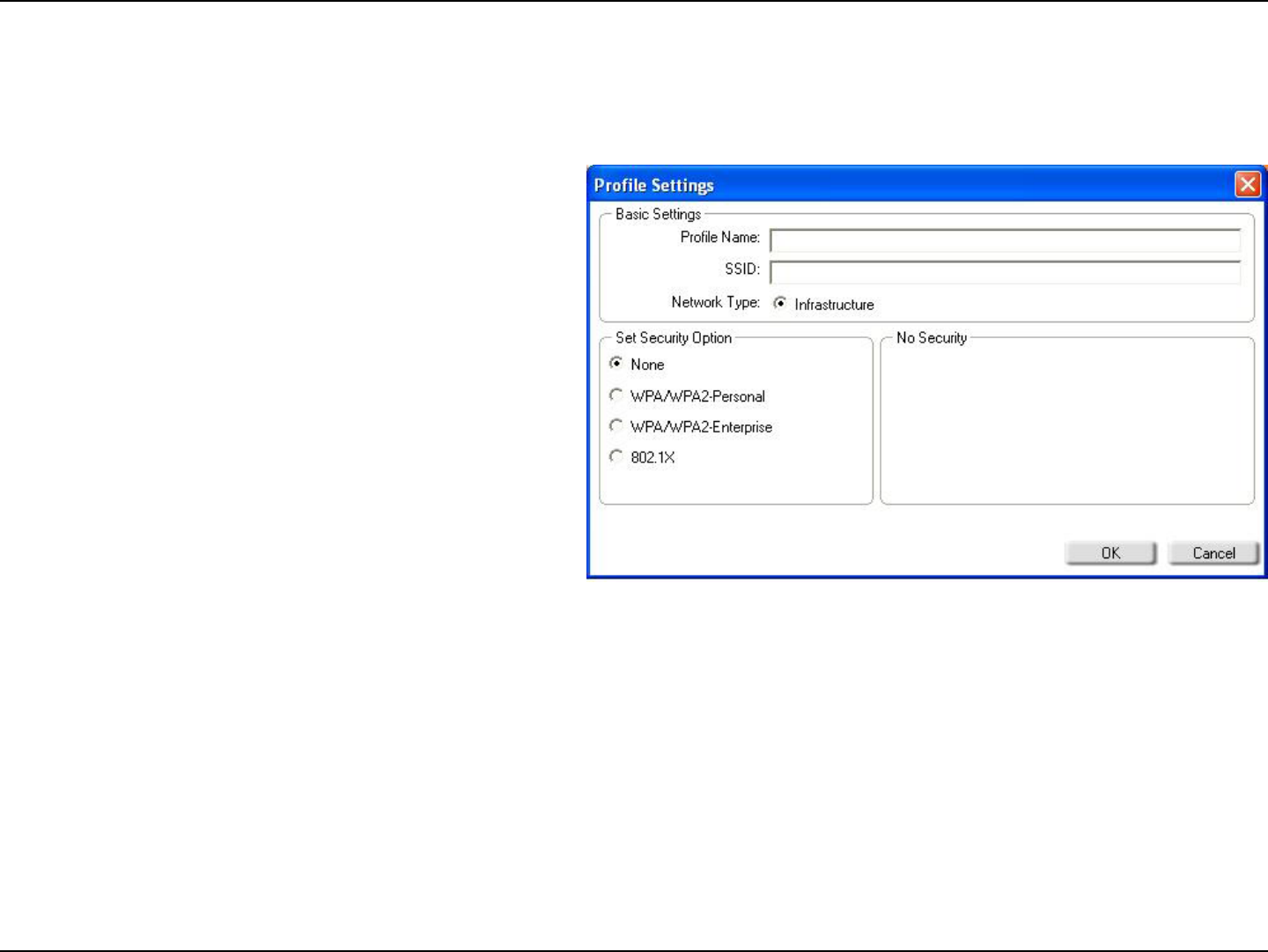
23D-Link DWA-130 User Manual
Section 3 - Configuration
Add Profile
You may add a new network by clicking the New button from the My Wireless Networks page.
Profile Name:
SSID:
Enter a name for your profile (e.g. Home, Office, Coffee
Shop).
Enter the SSID of the wireless network.
Select the network type. If you are connecting to a
wireless router or access point, select Infrastructure.
(Ad-hoc mode is not supported)
Select the type of security used. Please refer to the
Wireless Security section for more information.
Click OK to save your settings.
Network Type:
Security Type:
OK Button:
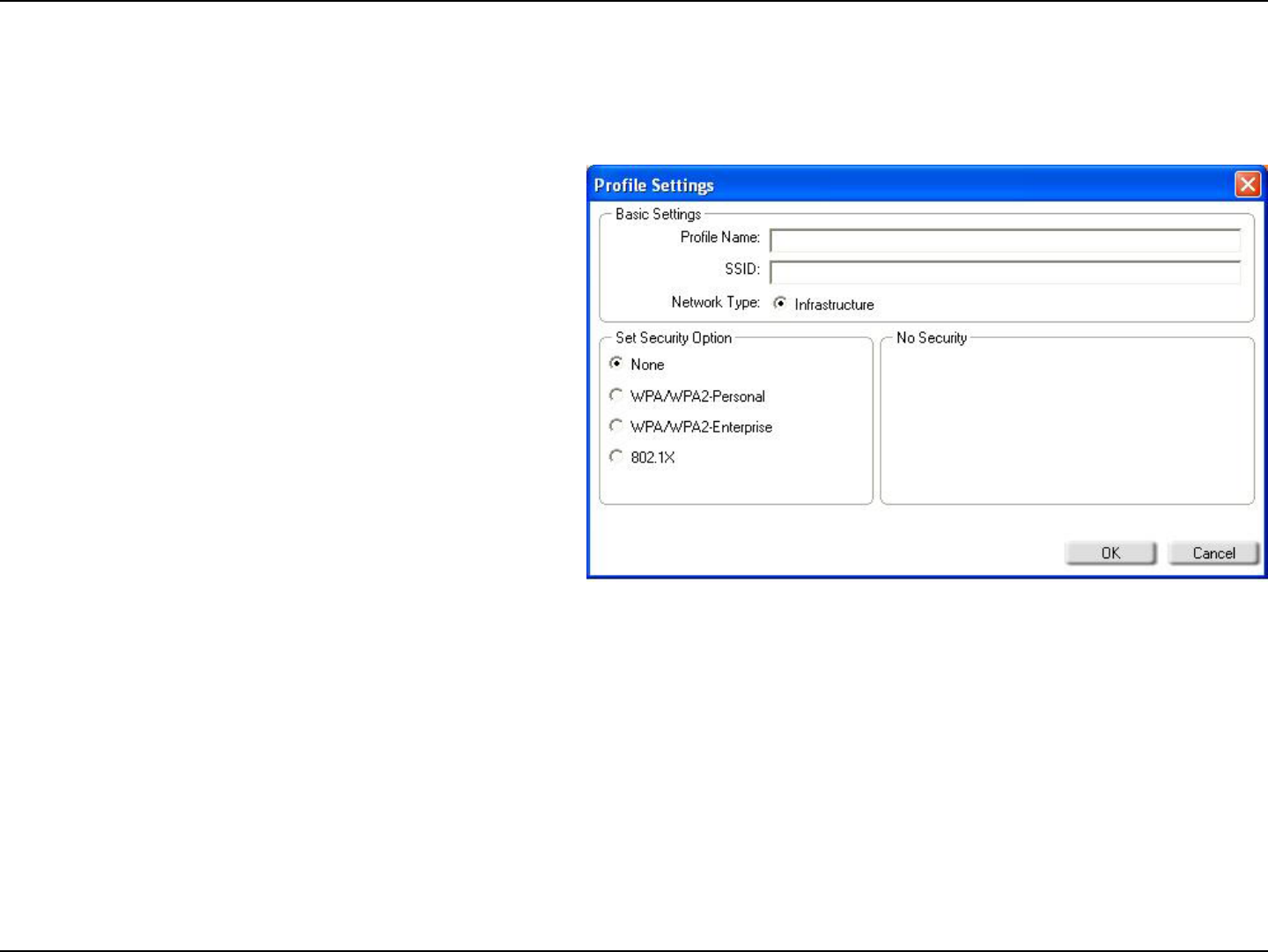
24D-Link DWA-130 User Manual
Section 3 - Configuration
Modify Profile
You may edit an existing profile by selecting the profile and clicking the Modify button from the My Wireless Networks page.
Profile Name:
SSID:
Enter a name for your profile (e.g. Home, Office,
Coffee Shop).
Displays the SSID of the network.
Displays the network type.
Select the type of security used. Please refer to the
Wireless Security section for more information.
Click OK to save your settings.
Network Type:
Security Type:
OK Button:
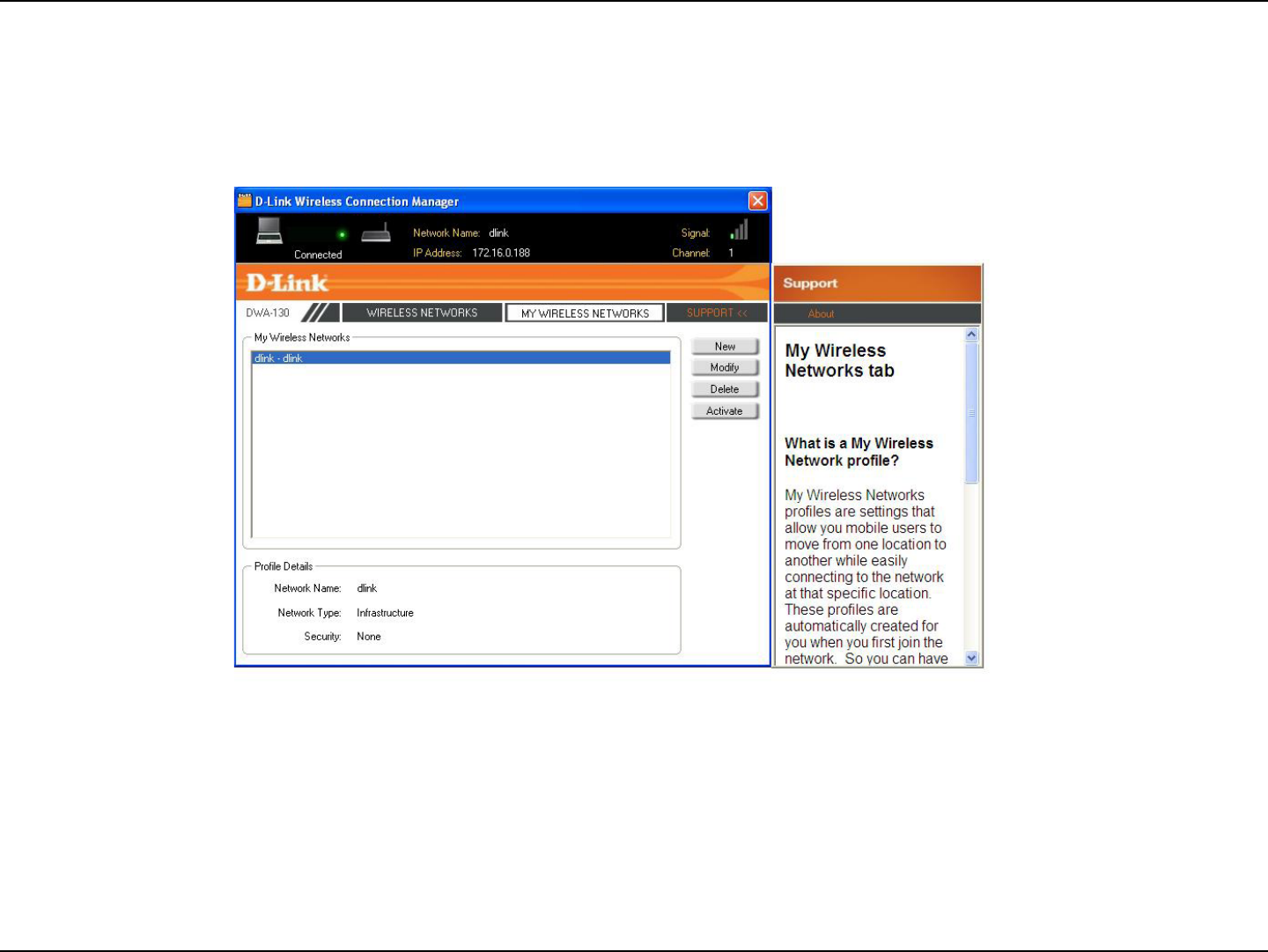
25D-Link DWA-130 User Manual
Section 3 - Configuration
Support
If you need help, click the Support button. A panel will appear to the right of the utility which will display information about the
utility.
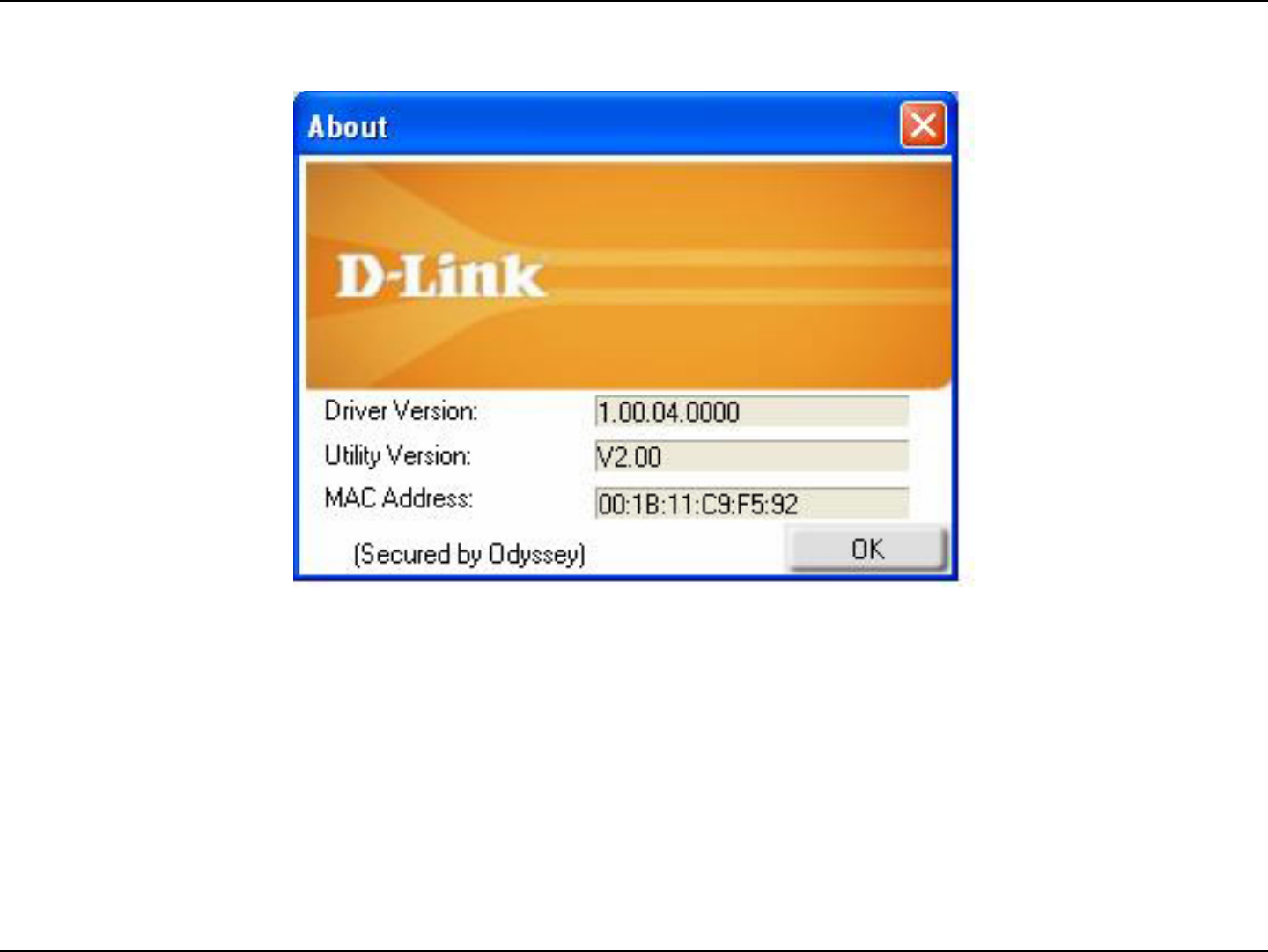
26D-Link DWA-130 User Manual
Section 3 - Configuration
The About screen gives you information about the Firmware and Utility Versions of the DWA-130.
About
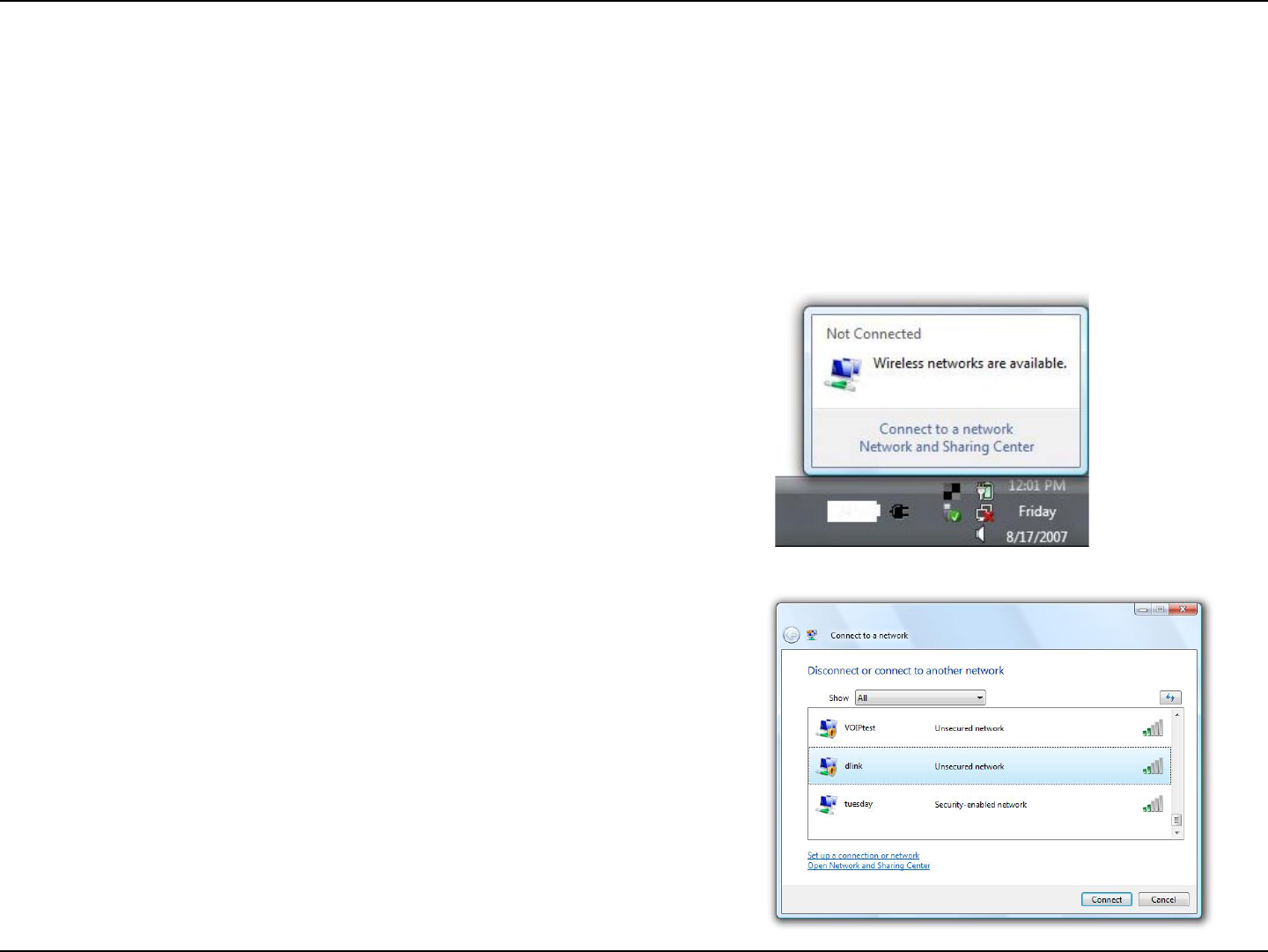
27D-Link DWA-130 User Manual
Section 3 - Configuration
Connect to a Wireless Network
Using Windows® Vista™
Windows® Vista™ users may use the built-in wireless utility. If you are using another company’s utility or Windows® 2000, please refer
to the user manual of your wireless adapter for help with connecting to a wireless network. Most utilities will have a “site survey”
option similar to the Windows® Vista™ utility as seen below.
Right-click on the wireless computer icon in your system tray (lower-
right corner next to the time). Select Connect to a network.
If you receive the Wireless Networks Detected bubble, click on the
center of the bubble to access the utility.
or
The utility will display any available wireless networks in your area.
Click on a network (displayed using the SSID) and click the Connect
button.
If you get a good signal but cannot access the Internet, check you TCP/
IP settings for your wireless adapter. Refer to the Networking Basics
section in this manual for more information.
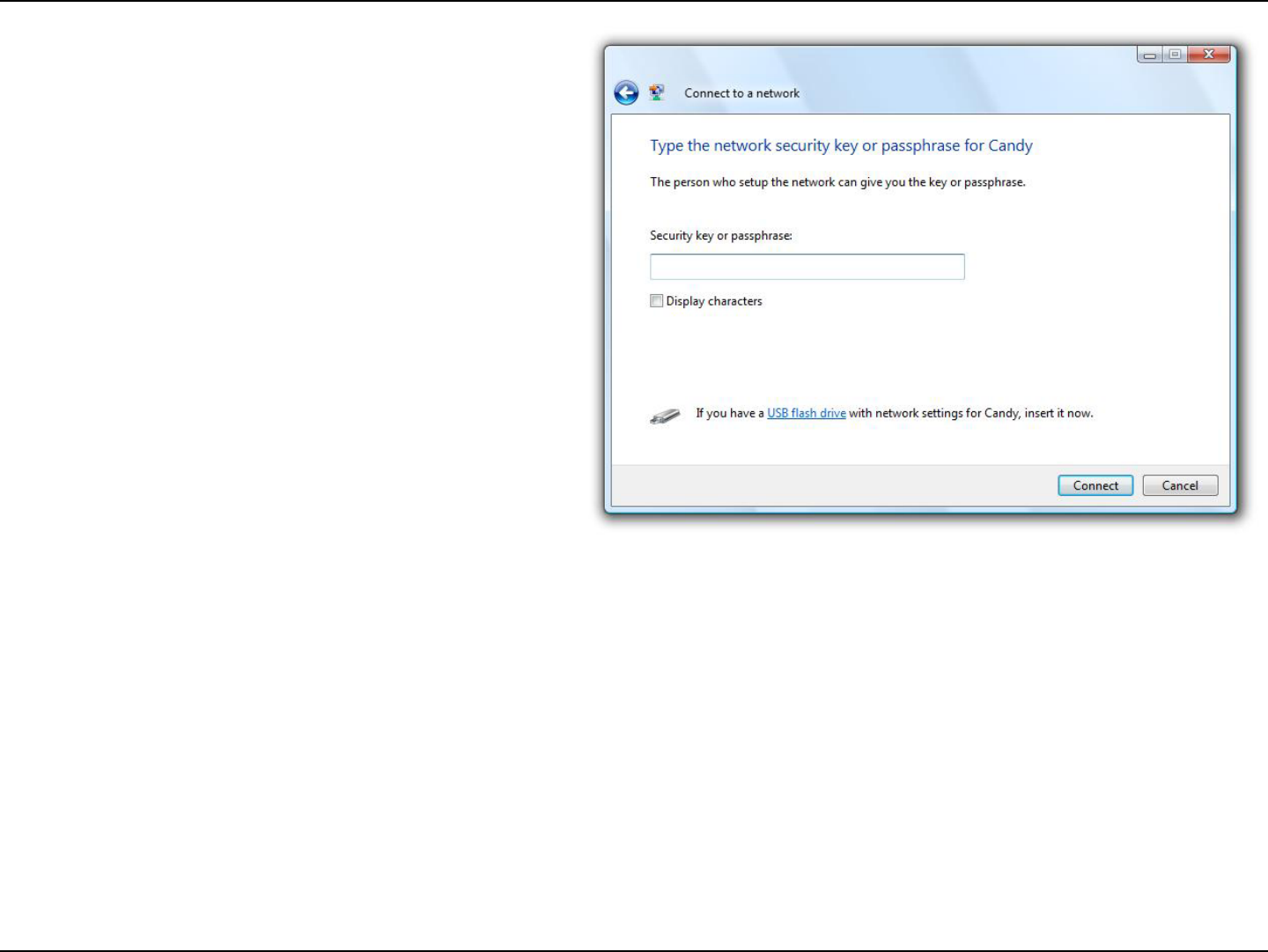
28D-Link DWA-130 User Manual
Section 3 - Configuration
Enter the same security key or passphrase that is on your
router and click Connect.
It may take 20-30 seconds to connect to the wireless
network. If the connection fails, please verify that the
security settings are correct. The key or passphrase must
be exactly the same as on the wireless router.
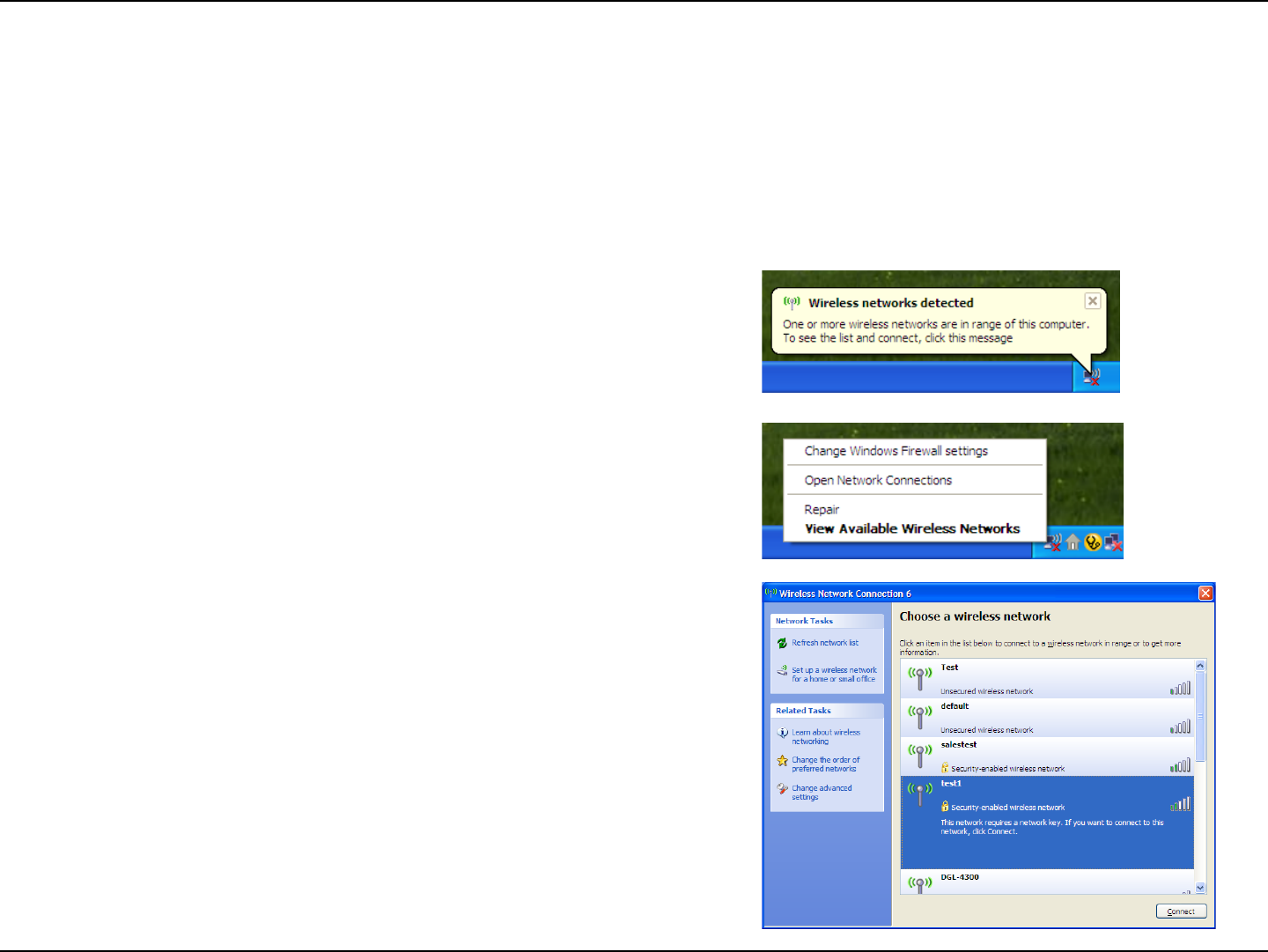
29D-Link DWA-130 User Manual
Section 3 - Configuration
Connect to a Wireless Network
Using Windows® XP
Windows® XP users may use the built-in wireless utility (Zero Configuration Utility). The following instructions are for Service Pack
2 users. If you are using another company’s utility or Windows® 2000, please refer to the user manual of your wireless adapter for
help with connecting to a wireless network. Most utilities will have a “site survey” option similar to the Windows® XP utility as seen
below.
Right-click on the wireless computer icon in your system tray
(lower-right corner next to the time). Select View Available Wireless
Networks.
If you receive the Wireless Networks Detected bubble, click on the
center of the bubble to access the utility.
or
The utility will display any available wireless networks in your area.
Click on a network (displayed using the SSID) and click the Connect
button.
If you get a good signal but cannot access the Internet, check you TCP/
IP settings for your wireless adapter. Refer to the Networking Basics
section in this manual for more information.

30D-Link DWA-130 User Manual
Section 4 - Wireless Security
Wireless Security
This section will show you the different levels of security you can use to protect your data from intruders. The
DWA-130 offers the following types of security:
• WPA2 (Wi-Fi Protected Access 2) • WPA2-PSK (Pre-Shared Key)
• WPA (Wi-Fi Protected Access) • WPA-PSK (Pre-Shared Key)
• 802.1x (RADIUS)
What is WPA?
WPA, or Wi-Fi Protected Access, is a Wi-Fi standard that was designed to improve the security features of WEP (Wired Equivalent
Privacy).
The 2 major improvements over WEP:
• Improved data encryption through the Temporal Key Integrity Protocol (TKIP). TKIP scrambles the keys using a
hashing algorithm and, by adding an integrity-checking feature, ensures that the keys haven’t been tampered with.
WPA2 is based on 802.11i and uses Advanced Encryption Standard instead of TKIP.
• User authentication, which is generally missing in WEP, through the extensible authentication protocol (EAP). WEP
regulates access to a wireless network based on a computer’s hardware-specific MAC address, which is relatively
simple to be sniffed out and stolen. EAP is built on a more secure public-key encryption system to ensure that only
authorized network users can access the network.
WPA-PSK/WPA2-PSK uses a passphrase or key to authenticate your wireless connection. The key is an alpha-numeric password
between 8 and 63 characters long. The password can include symbols (!?*&_) and spaces. This key must be the exact same key
entered on your wireless router or access point.
WPA/WPA2 incorporates user authentication through the Extensible Authentication Protocol (EAP). EAP is built on a more secure
public key encryption system to ensure that only authorized network users can access the network.
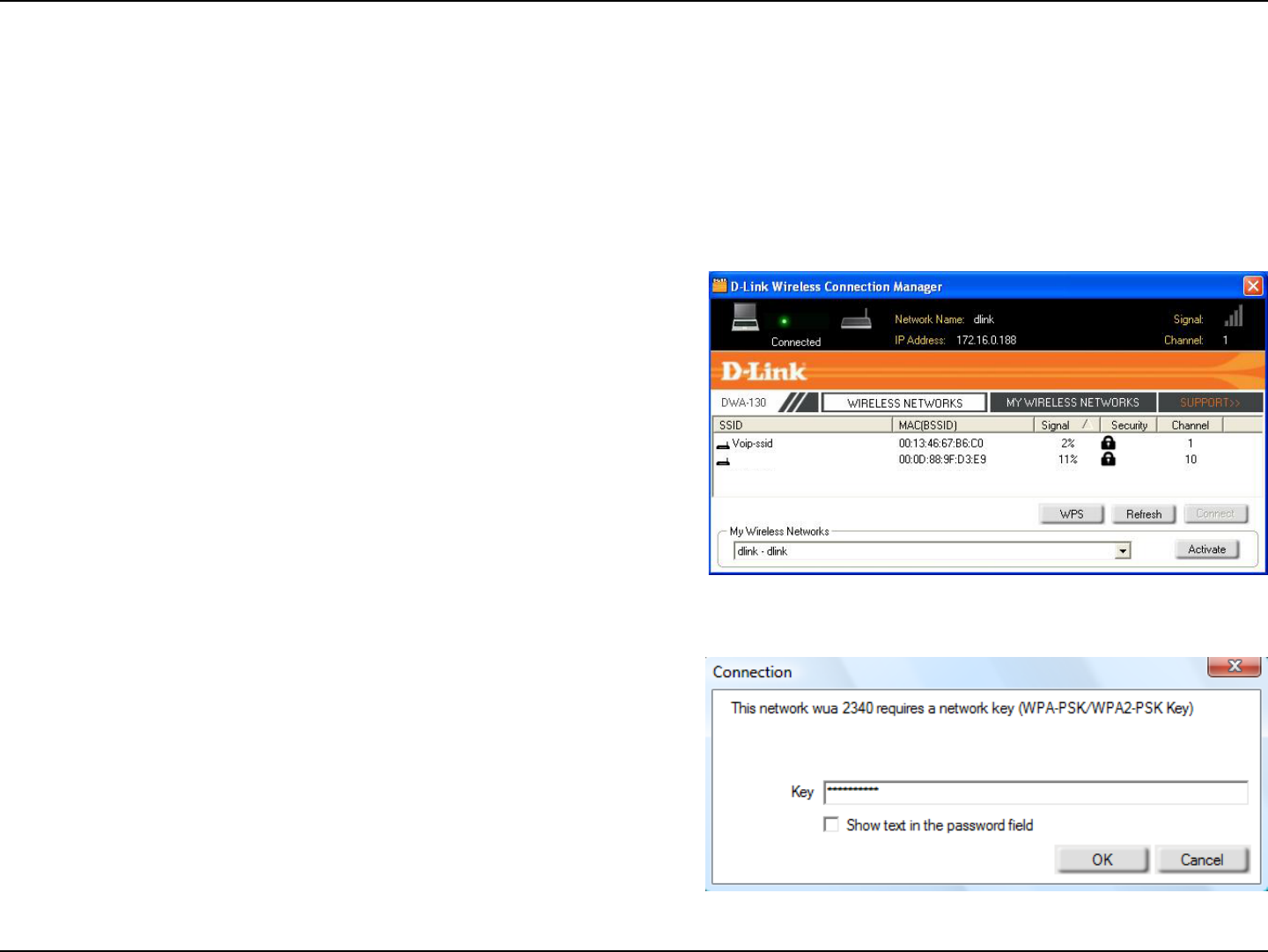
31D-Link DWA-130 User Manual
Section 4 - Wireless Security
Configure WPA/WPA2 Passphrase
Using the D-Link Wireless Connection Manager
It is recommended to enable WPA-PSK on your wireless router or access point before configuring your wireless adapter. If you are
joining an existing network, you will need to know the WPA-PSK passphrase being used.
1. Open the Wireless Connection Manager by double-clicking on the
D-Link icon on your desktop.
2. Highlight the wireless network (SSID) you would like to connect to
and click Connect. If the network is using WPA-PSK, the screen (as
shown to the bottom-right) will appear.
3. Enter the WPA-PSK passphrase exactly as it is on your wireless router
or access point. Click the Show text in the password field box to see
the passphrase. Unchecking it will hide it.
4. Click OK to connect to the network. Allow up to 30 seconds to
connect.
If you would like to create a new network and enter the WPA-PSK settings,
refer to the next page.
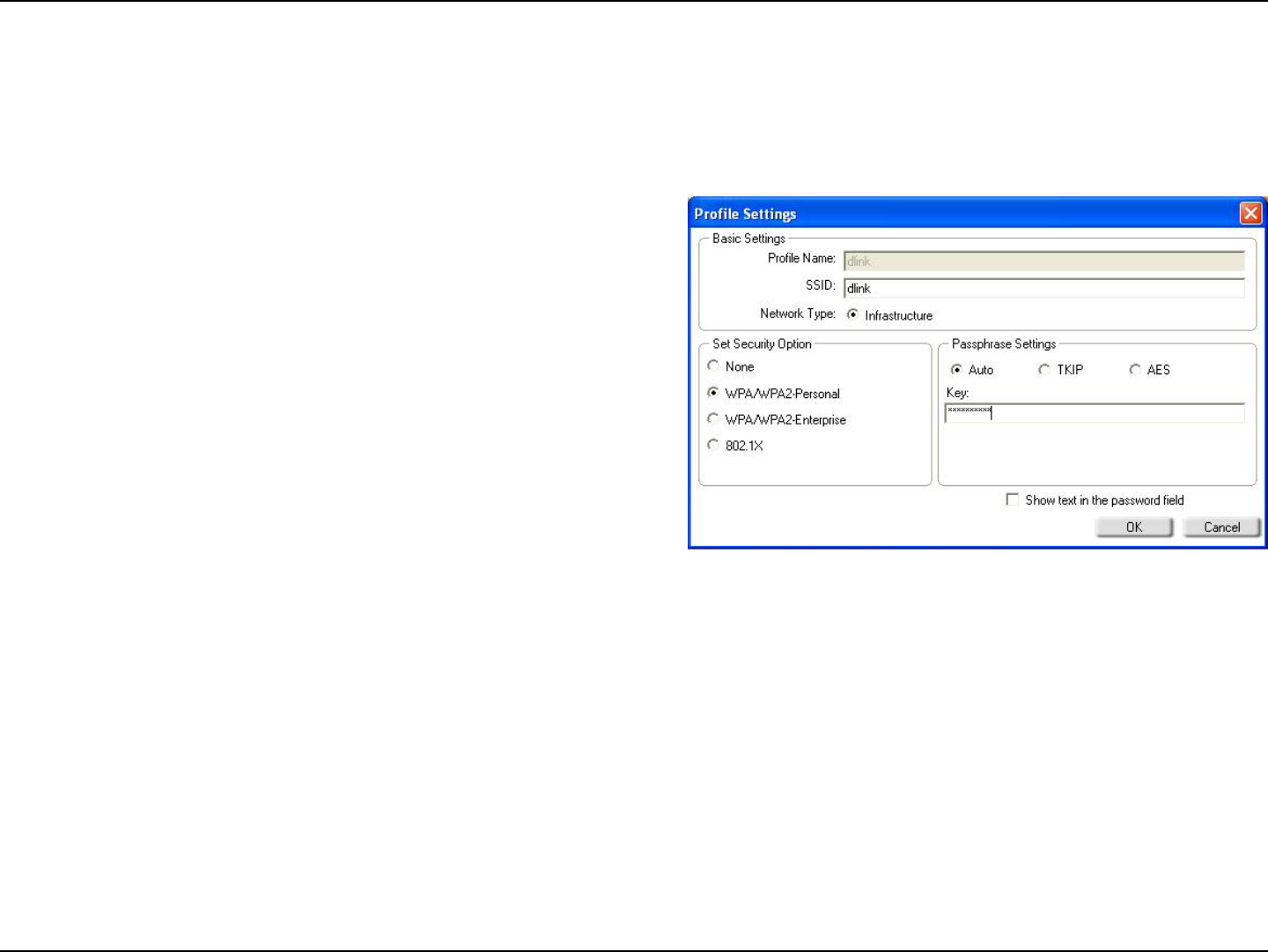
32D-Link DWA-130 User Manual
Section 4 - Wireless Security
It is recommended to enable WPA-PSK on your wireless router or access point before configuring your wireless adapter. Make sure
you enter the passphrase exactly the same on all wireless devices.
1. Open the Wireless Connection Manager by double-clicking on the D-Link icon on your desktop. Click on New to create a new
profile or highlight an existing profile and click Modify.
2. Select WPA/WPA2-Personal under Set Security Option.
3. Select TKIP or AES.
4. Enter the passphrase exactly as it is on your wireless router or
access point.
5. Click OK to connect to the network. Allow up to 30 seconds to
connect.
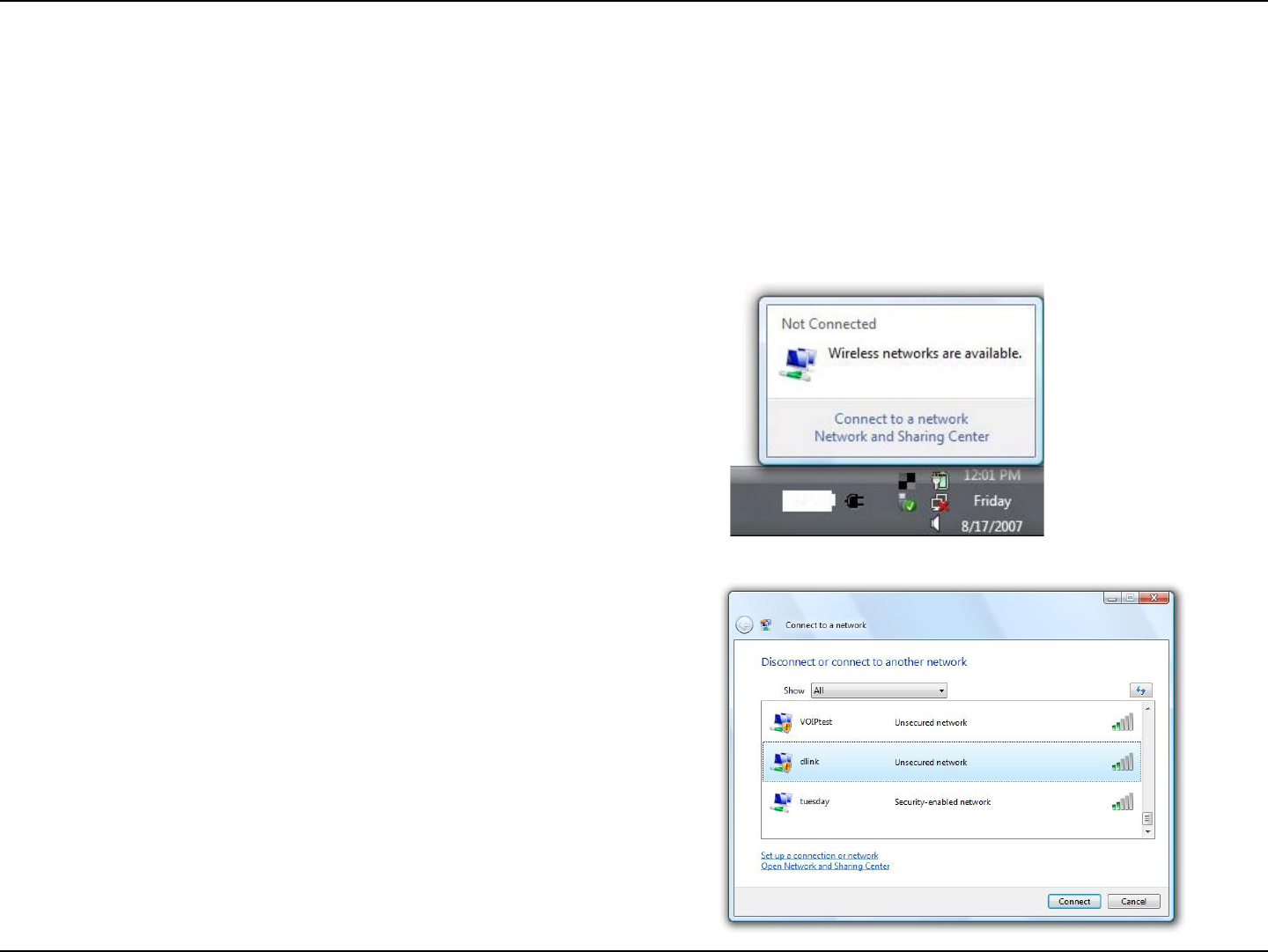
33D-Link DWA-130 User Manual
Section 4 - Wireless Security
Configure WPA/WPA2 Passphrase
Using Windows® Vista
It is recommended to enable wireless security (WPA/WPA2) on your wireless router or access point before configuring your wireless
adapter. If you are joining an existing network, you will need to know the security key or passphrase being used.
2. Highlight the wireless network (SSID) you would like to
connect to and click Connect.
1. Open the Windows® Vista™ Wireless Utility by right-clicking on the
wireless computer icon in your system tray (lower right corner of
screen). Select Connect to a network.
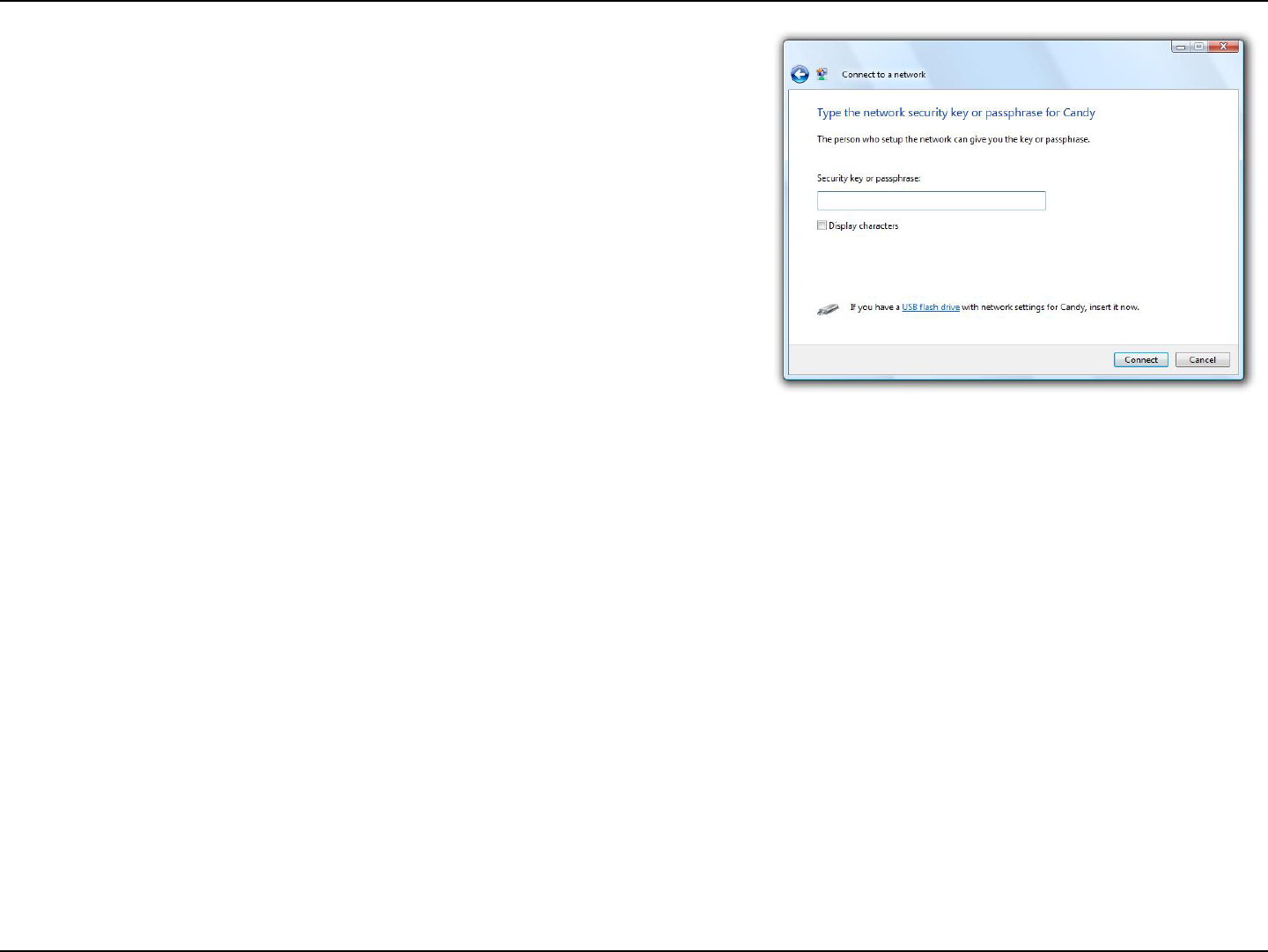
34D-Link DWA-130 User Manual
Section 4 - Wireless Security
3. Enter the same security key or passphrase that is on your router and click
Connect.
It may take 20-30 seconds to connect to the wireless network. If the connection
fails, please verify that the security settings are correct. The key or passphrase
must be exactly the same as on the wireless router.
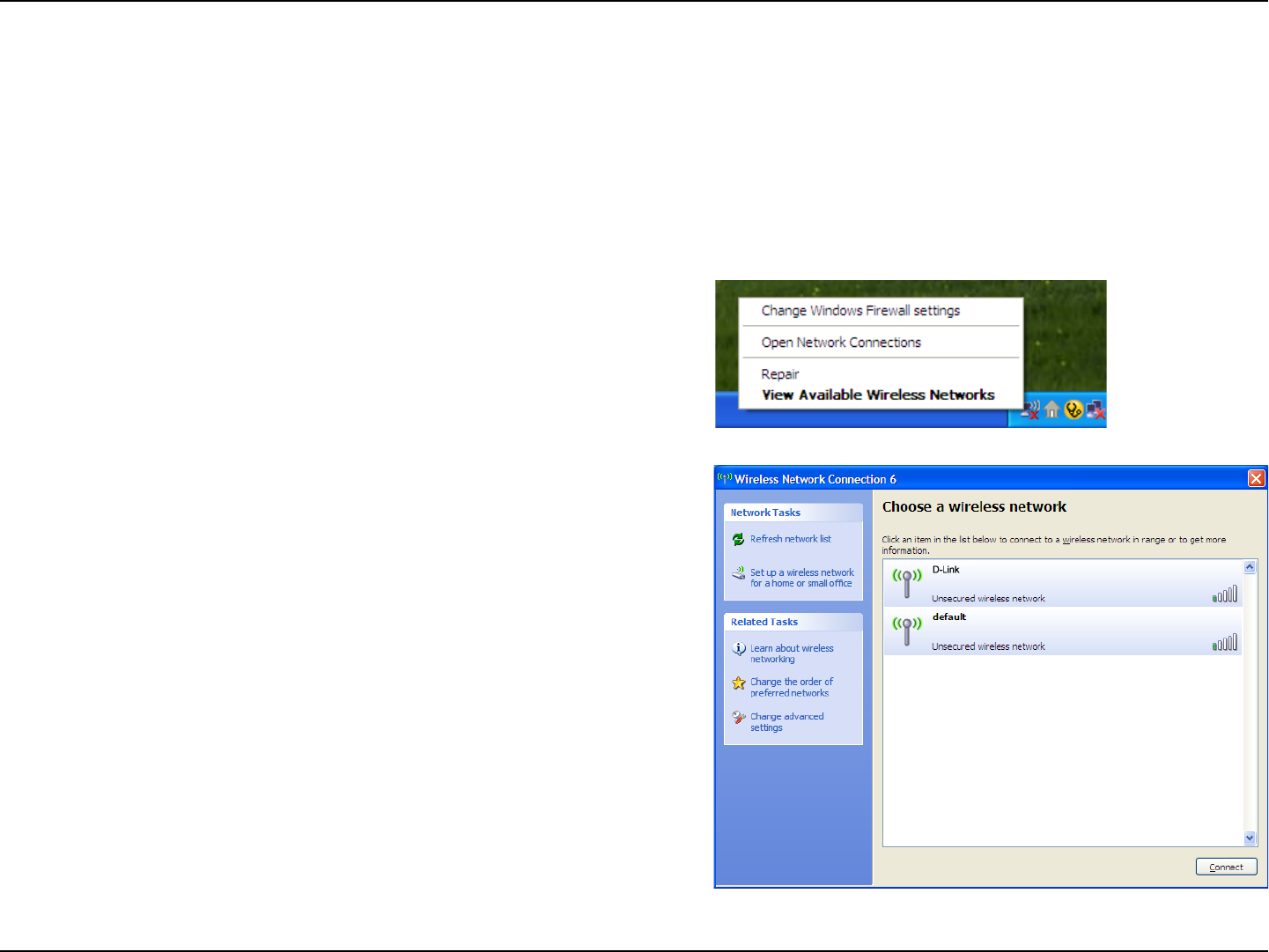
35D-Link DWA-130 User Manual
Section 4 - Wireless Security
Configure WPA/WPA2 Passphrase
Using the Windows® XP Utility
It is recommended to enable WPA-PSK on your wireless router or access point before configuring your wireless adapter. If you are
joining an existing network, you will need to know the WPA-PSK key being used.
2. Highlight the wireless network (SSID) you would like to
connect to and click Connect.
1. Open the Windows® XP Wireless Utility by right-clicking
on the wireless computer icon in your system tray
(lower-right corner of screen). Select View Available Wireless
Networks.
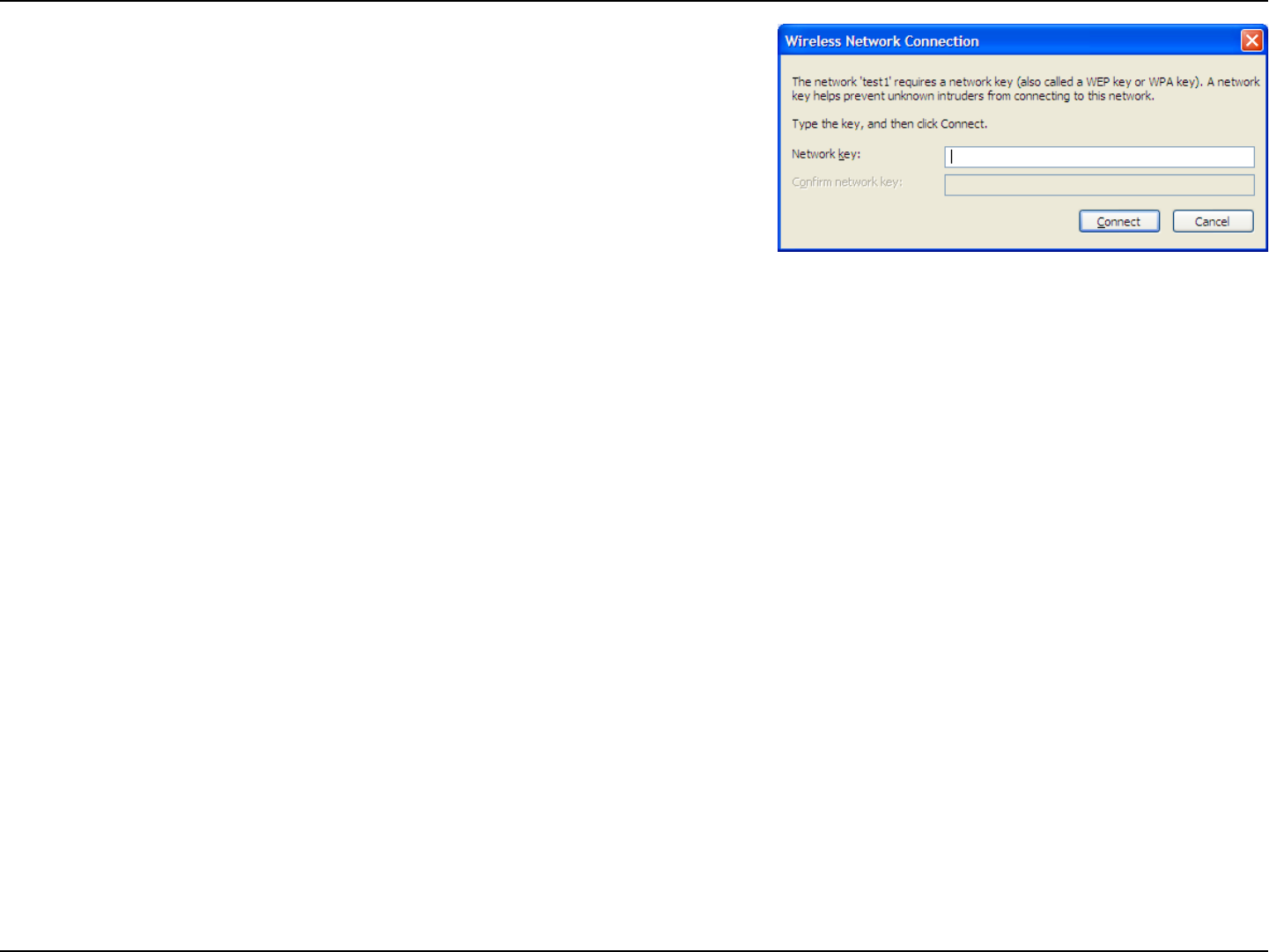
36D-Link DWA-130 User Manual
Section 4 - Wireless Security
3. The Wireless Network Connection box will appear. Enter the WPA-PSK
passphrase and click Connect.
It may take 20-30 seconds to connect to the wireless network. If the connection
fails, please verify that the WPA-PSK settings are correct. The WPA-PSK
passphrase must be exactly the same as on the wireless router or access
point.